Yamaha CLP-990M, CLP-990 User Manual
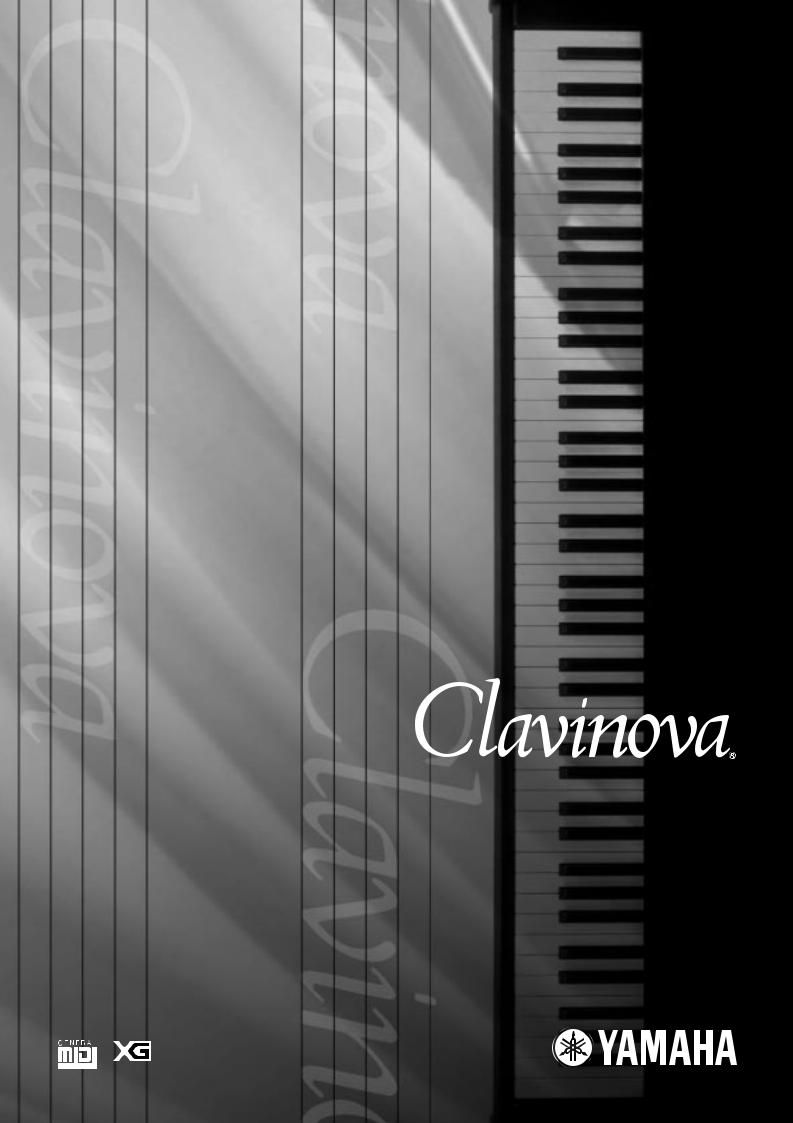
IMPORTANT
Check your power supply
Make sure that your local AC mains voltage matches the voltage specified on the name plate on the bottom panel. In some areas a voltage selector may be provided on the bottom panel of the main keyboard unit near the power cord. Make sure that the voltage selector is set for the voltage in your area. The voltage selector is set at 240V when the unit is initially shipped. To change the setting use a “minus” screwdriver to rotate the selector dial so that the correct voltage appears next to the pointer on the panel.
CLP-990 CLP-990M
Owner’s manual

SPECIAL MESSAGE SECTION
PRODUCT SAFETY MARKINGS: Yamaha electronic products may have either labels similar to the graphics shown below or molded/stamped facsimiles of these graphics on the enclosure. The explanation of these graphics appears on this page. Please observe all cautions indicated on this page and those indicated in the safety instruction section.
CAUTION |
RISK OF ELECTRIC SHOCK |
DO NOT OPEN |
CAUTION: TO REDUCE THE RISK OF ELECTRIC SHOCK. |
DO NOT REMOVE COVER (OR BACK). |
NO USER-SERVICEABLE PARTS INSIDE. |
REFER SERVICING TO QUALIFIED SERVICE PERSONNEL. |
See bottom of Keyboard enclosure for graphic symbol markings
The exclamation point within the equilateral triangle is intended to alert the user to the presence of important operating and maintenance (servicing) instructions in the literature accompanying the product.
The lightning flash with arrowhead symbol, within the equilateral triangle, is intended to alert the user to the presence of uninsulated “dangerous voltage” within the product’s enclosure that may be of sufficient magnitude to constitute a risk of electrical shock.
IMPORTANT NOTICE: All Yamaha electronic products are tested and approved by an independent safety testing laboratory in order that you may be sure that when it is properly installed and used in its normal and customary manner, all foreseeable risks have been eliminated. DO NOT modify this unit or commission others to do so unless specifically authorized by Yamaha. Product performance and/or safety standards may be diminished. Claims filed under the expressed warranty may be denied if the unit is/has been modified. Implied warranties may also be affected.
SPECIFICATIONS SUBJECT TO CHANGE: The information contained in this manual is believed to be correct at the time of printing. However, Yamaha reserves the right to change or modify any of the specifications without notice or obligation to update existing units.
ENVIRONMENTAL ISSUES: Yamaha strives to produce products that are both user safe and environmentally friendly. We sincerely believe that our products and the production methods used to produce them, meet these goals. In keeping with both the letter and the spirit of the law, we want you to be aware of the following:
Battery Notice: This product MAY contain a small nonrechargable battery which (if applicable) is soldered in place. The average life span of this type of battery is approximately five years. When replacement becomes necessary, contact a qualified service representative to perform the replacement.
Warning: Do not attempt to recharge, disassemble, or incinerate this type of battery. Keep all batteries away from children. Dispose of used batteries promptly and as regulated by applicable laws. Note: In some areas, the servicer is required by law to return the defective parts. However, you do have the option of having the servicer dispose of these parts for you.
Disposal Notice: Should this product become damaged beyond repair, or for some reason its useful life is considered to be at an end, please observe all local, state, and federal regulations that relate to the disposal of products that contain lead, batteries, plastics, etc.
NOTICE: Service charges incurred due to lack of knowledge relating to how a function or effect works (when the unit is operating as designed) are not covered by the manufacturer’s warranty, and are therefore the owners responsibility. Please study this manual carefully and consult your dealer before requesting service.
NAME PLATE LOCATION: The graphic below indicates the location of the name plate. The model number, serial number, power requirements, etc., are located on this plate. You should record the model number, serial number, and the date of purchase in the spaces provided below and retain this manual as a permanent record of your purchase.
CLP-990/990M
Model
Serial No.
Purchase Date
92-469 1
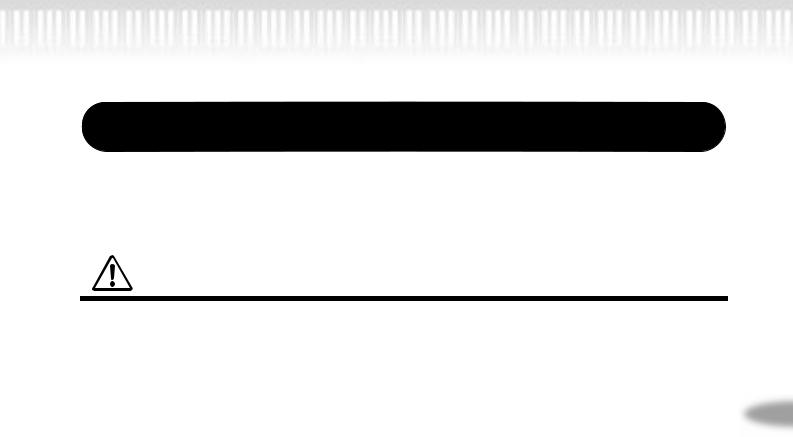
PRECAUTIONS
PLEASE READ CAREFULLY BEFORE PROCEEDING
* Please keep these precautions in a safe place for future reference.
WARNING
Always follow the basic precautions listed below to avoid the possibility of serious injury or even death from electrical shock, short-circuiting, damages, fire or other hazards. These precautions include, but are not limited to, the following:
•Do not open the instrument or attempt to disassemble the internal parts or modify them in any way. The instrument contains no user-serviceable parts. If it should appear to be malfunctioning, discontinue use immediately and have it inspected by qualified Yamaha service personnel.
•Do not expose the instrument to rain, use it near water or in damp or wet conditions, or place containers on it containing liquids which might spill into any openings.
•If the power cord or plug becomes frayed or damaged, or if there is a sudden loss of sound during use of the instrument, or if any unusual smells or smoke should appear to be caused by it, immediately turn off the power switch, disconnect the electric plug from the outlet, and have the instrument inspected by qualified Yamaha service personnel.
•Only use the voltage specified as correct for the instrument. The required voltage is printed on the name plate of the instrument.
•Before cleaning the instrument, always remove the electric plug from the outlet. Never insert or remove an electric plug with wet hands.
•Check the electric plug periodically and remove any dirt or dust which may have accumulated on it.
(1) B-6
CLP-990 3

PRECAUTIONS
CAUTION
Always follow the basic precautions listed below to avoid the possibility of physical injury to you or others, or damage to the instrument or other property. These precautions include, but are not limited to, the following:
•Do not place the power cord near heat sources such as heaters or radiators, and do not excessively bend or otherwise damage the cord, place heavy objects on it, or place it in a position where anyone could walk on, trip over, or roll anything over it.
•When removing the electric plug from the instrument or an outlet, always hold the plug itself and not the cord. Pulling by the cord can damage it.
•Do not connect the instrument to an electrical outlet using a multiple-connector. Doing so can result in lower sound quality, or possibly cause overheating in the outlet.
•Remove the electric plug from the outlet when the instrument is not to be used for extended periods of time, or during electrical storms.
•Before connecting the instrument to other electronic components, turn off the power for all components. Before turning the power on or off for all components, set all volume levels to minimum. Also, be sure to set the volumes of all components at their minimum levels and gradually raise the volume controls while playing the instrument to set the desired listening level.
•Do not expose the instrument to excessive dust or vibrations, or extreme cold or heat (such as in direct sunlight, near a heater, or in a car during the day) to prevent the possibility of panel disfiguration or damage to the internal components.
•Do not use the instrument near other electrical products such as televisions, radios, or speakers, since this might cause interference which can affect proper operation of the other products.
•Do not place the instrument in an unstable position where it might accidentally fall over.
•Before moving the instrument, remove all connected cables.
•When cleaning the instrument, use a soft, dry or slightly damp cloth. Do not use paint thinners, solvents, cleaning fluids, or chemical-impregnated wiping cloths. Also, do not place vinyl, plastic or rubber objects on the instrument, since this might discolor the panel or keyboard.
•Do not rest your weight on, or place heavy objects on the instrument, and do not use excessive force on the buttons, switches or connectors.
•Take care that the key cover does not pinch your fingers, and do not insert a finger or hand in the key cover gap.
•Never insert or drop paper or metallic or other objects between the slits of the key cover and the keyboard. If this happens, immediately turn off the power and remove the electric plug from the outlet and have the instrument inspected by qualified Yamaha service personnel.
•Do not place the instrument against a wall (allow at least 3 cm/one-inch from the wall), since this can cause inadequate air circulation, and possibly result in the instrument overheating.
•Read carefully the attached documentation explaining the assembly process. Failure to assemble the instrument in the proper sequence might result in damage to the instrument or even injury.
•Do not operate the instrument for a long period of time at a high or uncomfortable volume level, since this can cause permanent hearing loss. If you experience any hearing loss or ringing in the ears, consult a physician.
(1) B-6
4 CLP-990
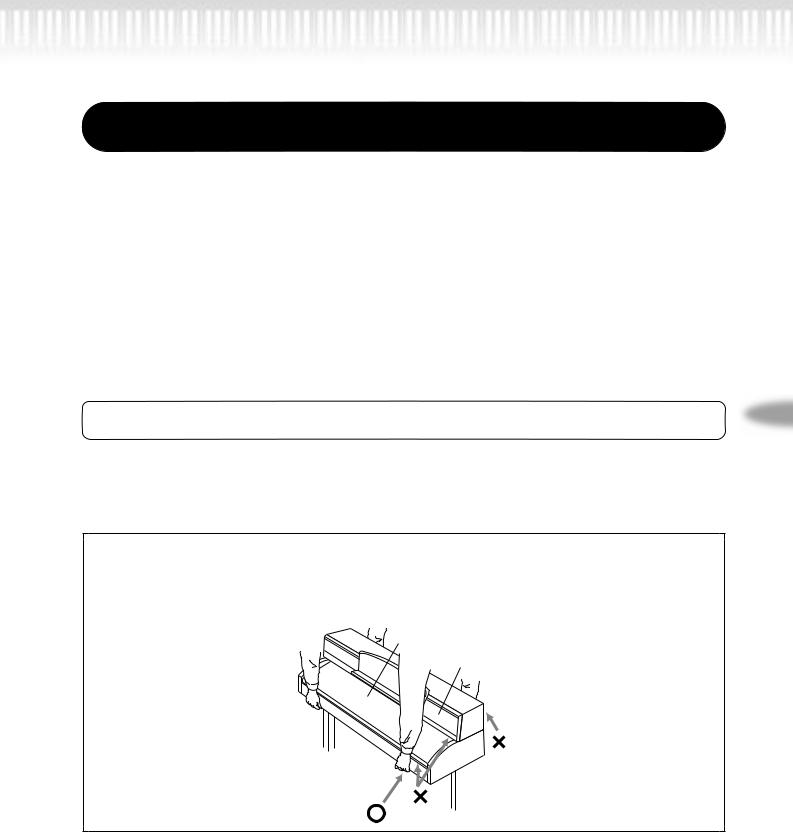
PRECAUTIONS
■ USING THE BENCH (If included)
•Do not play carelessly with or stand on the bench. Using it as a tool or step-ladder or for any other purpose might result in accident or injury.
•Only one person should sit on the bench at a time, in order to prevent the possibility of accident or injury.
•If the bench screws become loose due to extensive long-term use, tighten them periodically using the included tool.
■ SAVING USER DATA
•Always save data to a floppy disk or an external device such as the Yamaha MIDI Data Filer MDF3 frequently, in order to help prevent the loss of important data due to a malfunction or user operating error.
Yamaha cannot be held responsible for damage caused by improper use or modifications to the instrument, or data that is lost or destroyed.
Always turn the power off when the instrument is not in use.
When moving the instrument after assembly, always hold the bottom of the instrument and the handles located on the rear.
Do not hold the keyboard cover or speaker box. Improper handling can result in damage to the instrument or personal injury.
Key cover
Speaker box
(1) B-6
CLP-990 5
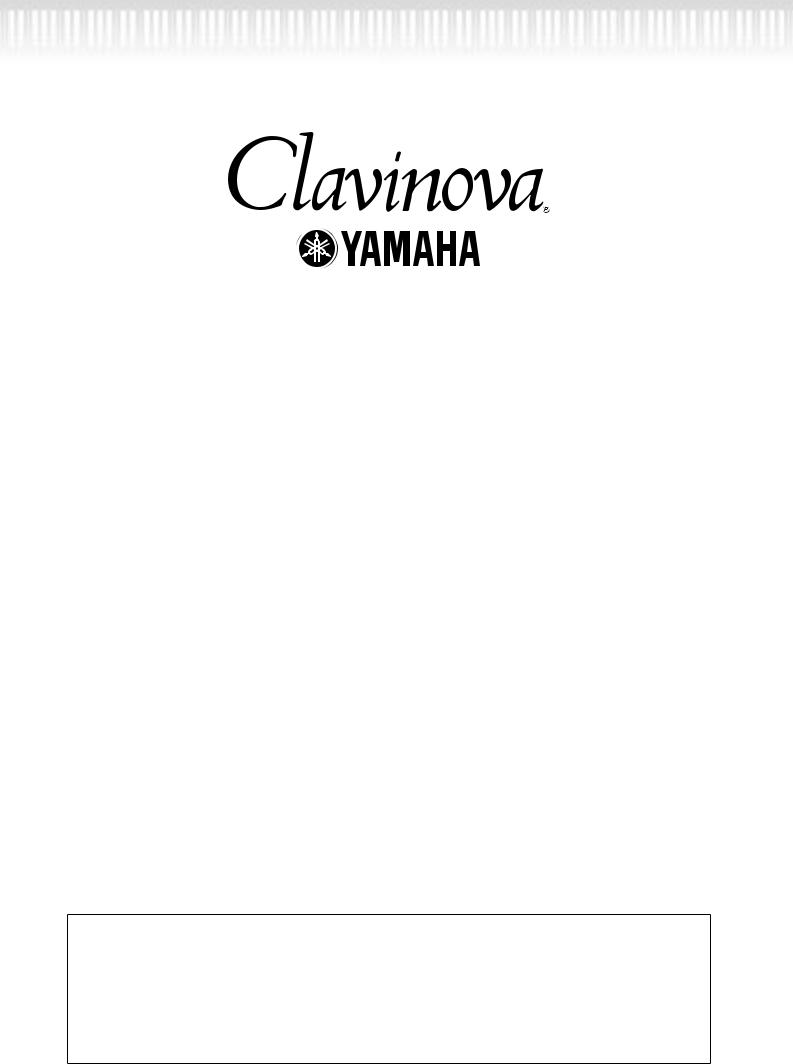
Thank you for choosing the Yamaha Clavinova CLP-990/990M. In order to make the most of your Clavinova’s performance potential and features, please read this Owner’s Manual thoroughly, and keep it in a safe place for later reference.
About this Owner’s Manual and Reference Booklet
This manual consists of four main sections: “Introduction,” “Basic Operation,” “Detailed Settings,” and “Appendix.” Also, a separate “Reference Booklet” is provided.
Introduction: Please read this section first. In the “Application Index” section on page 11 and “Features” on page 16, you can learn how to use the Clavinova and its functions in particular situations.
Basic Operation:
Detailed Settings:
Appendix:
This main section explains how to use the basic functions. Refer to this section while you play the Clavinova. If you have questions or come across the words you do not know, refer to the section entitled “Questions about Operations and Functions” on page 97, or the “Index” on page 106.
This section explains how to make detailed settings for the Clavinova’s various functions. Refer to this section as necessary.
This section introduces troubleshooting, a description of preset voices, and other reference material.
Reference Booklet: XG Voice List, MIDI Data Format, etc.
*The models CLP-990M will be referred to as the CLP-990 in this Owner’s Manual.
•The illustrations and LCD screens as shown in this Owner’s Manual are for instructional purposes only, and may appear somewhat different from those on your instrument.
•Unauthorized copying of copyrighted software for purposes other than the purchaser’s personal use is prohibited.
■ Trademarks
•Apple and Macintosh are trademarks of Apple Computer, Inc., registered in the U.S. and other countries.
•IBM-PC/AT is a trademark of International Business Machines Corporation.
•Windows is the registered trademark of Microsoft® Corporation.
All other trademarks are the property of their respective holders.
“The Clavinova-Computer Connection” is a supplementary guidebook that describes, for beginners, what you can do with your Clavinova and a personal computer and how to set up a Clavinova-Computer system (the manual is not written for any specific models). The document is available as a PDF file (in English) at the following Internet address:
Clavinova Web site:
http://www.yamaha.co.jp/english/product/cl/
Yamaha Manual Library (Electronic Musical Instruments)
http://www2.yamaha.co.jp/manual/english/
6 CLP-990
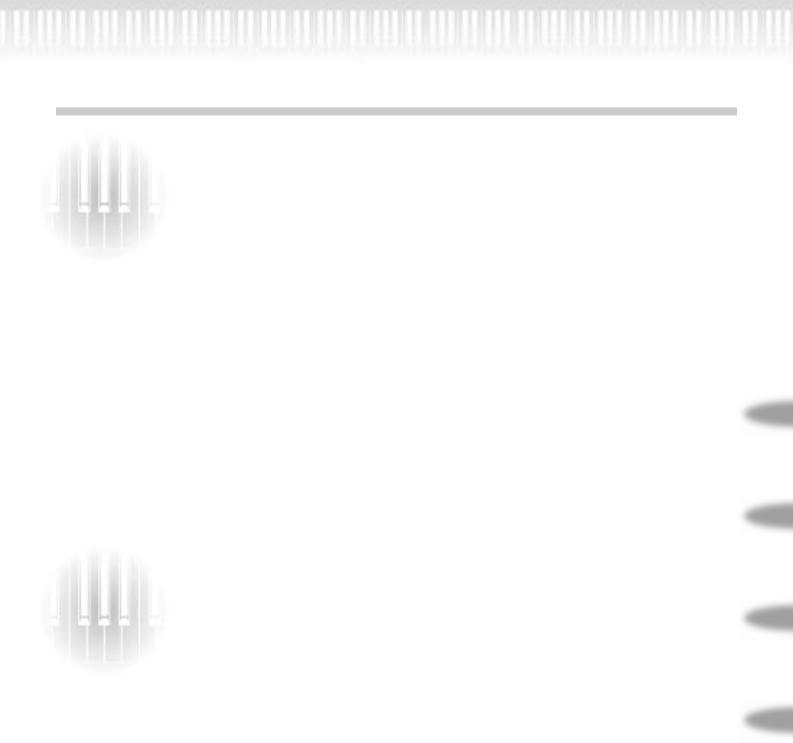
Table of contents
Introduction.......................................................... |
2 |
PRECAUTIONS ........................................................................................................................................ |
3 |
About this Owner’s Manual and Reference Booklet..................................................................................................... |
6 |
Table of contents ................................................................................................................................... |
7 |
Application Index |
|
Use this index to find reference pages that may be helpful for your application and situation. .............................. |
11 |
Handling the Floppy Disk Drive(FDD) and Floppy Disk ...................................................................... |
13 |
Maintenance ........................................................................................................................................ |
14 |
Included Accessories ............................................................................................................................ |
15 |
Features ................................................................................................................................................ |
16 |
Before Using the Clavinova.................................................................................................................. |
18 |
Key cover ....................................................................................................................................................................... |
18 |
Music stand ................................................................................................................................................................... |
18 |
Turning the power on................................................................................................................................................... |
19 |
Adjusting the display contrast ...................................................................................................................................... |
20 |
Setting the volume ........................................................................................................................................................ |
20 |
Using headphones......................................................................................................................................................... |
20 |
Basic Operation .................................................. |
21 |
Part Names ........................................................................................................................................... |
22 |
Listening to the Demonstration Tunes................................................................................................ |
24 |
Listening to 50 Piano Preset Songs ..................................................................................................... |
26 |
Playing the 50 piano preset songs ................................................................................................................................ |
26 |
Practicing a one-hand part using 50 preset songs ....................................................................................................... |
28 |
Selecting and Playing Voices ............................................................................................................... |
30 |
Selecting Voices............................................................................................................................................................. |
30 |
Using the pedals ............................................................................................................................................................ |
31 |
Adding variation to the sound [BRILLIANCE]/[REVERB]/[CHORUS].................................................................. |
32 |
Transposition ... [TRANSPOSE].................................................................................................................................. |
34 |
Combining two voices (Dual mode)............................................................................................................................ |
35 |
Splitting the keyboard range and playing two different voices (Split mode) ............................................................ |
37 |
Using the metronome ................................................................................................................................................... |
40 |
Recording Your Performance............................................................................................................... |
41 |
Recording a New Song.................................................................................................................................................. |
41 |
Recording to [TRACK 1]........................................................................................................................................ |
41 |
Re-recording TRACK 1........................................................................................................................................... |
43 |
Re-recording TRACK 1 partially............................................................................................................................ |
44 |
Recording to [TRACK2]......................................................................................................................................... |
45 |
Recording to the third or more tracks [EXTRA TRACKS] .................................................................................. |
46 |
Other recording techniques.......................................................................................................................................... |
46 |
Adding data to or recording over an existing song ............................................................................................... |
46 |
CLP-990 7

Table of contents
Changing a voice or tempo after recording |
........................................................................................................... |
|
47 |
Adjusting the volume balance between playback and your performance [SONG BALANCE] ......................... |
48 |
||
Recording in Dual or Split mode ........................................................................................................................... |
|
|
49 |
Saving Recorded Songs and Handling the Files... ......................................................................[FILE] |
|
50 |
|
Clavinova memory.................................................................................................................................................. |
|
|
50 |
Basic file operation.................................................................................................................................................. |
|
|
51 |
Saving recorded or other songs to Clavinova Storage ... .................................................memory |
[SaveToMemory] |
52 |
|
Saving recorded or other songs to floppy disk... .................................................................................. |
[SaveToDisk] |
|
53 |
Deleting songs in Clavinova Storage memory or ... .........................................................a floppy disk |
[DeleteSong] |
53 |
|
Renaming a song...[RenameSong] ............................................................................................................................... |
|
|
54 |
Copying data from one floppy disk to another... .................................................................................... |
[CopyDisk] |
|
55 |
Formatting a floppy disk...[FormatDisk] .................................................................................................................... |
|
|
56 |
Changing the type of characters on screen...[CharacterCode]................................................................................... |
|
56 |
|
Playing Back Recorded Songs and Commercially .............................................-available Music Data |
57 |
||
Playing back a song ....................................................................................................................................................... |
|
|
57 |
Turning track playback on and off............................................................................................................................... |
|
|
59 |
Supported song data type ............................................................................................................................................. |
|
|
59 |
Connections ......................................................................................................................................... |
|
|
61 |
Connectors .................................................................................................................................................................... |
|
|
61 |
Connecting a personal computer................................................................................................................................. |
|
|
63 |
Detailed Settings ................................................ |
69 |
Detailed Settings.................................................................................................................................. |
70 |
Parameter List ............................................................................................................................................................... |
70 |
Making detailed settings ............................................................................................................................................... |
72 |
Detailed settings for recording and playback [SONG SETTING] ........................................................ |
74 |
Correcting note timing [Quantize].............................................................................................................................. |
74 |
Specifying whether playback starts immediately along with the first voicing [QuickPlay] ...................................... |
75 |
Auditioning the channels [ChannelListen] ................................................................................................................. |
75 |
Deleting data from each channel [ChannelClear]....................................................................................................... |
75 |
Specifying the range and playing back repeatedly [FromToRepeat] ......................................................................... |
75 |
Playing back the phrase specified by the phrase number [PhraseMark] ................................................................... |
76 |
Playing back a song repeatedly [SongRepeat] ............................................................................................................. |
76 |
Detailed settings for the metronome METRONOME [SETTING] ........................................................ |
77 |
Setting the metronome time signature [TimeSignature]............................................................................................ |
77 |
Setting the metronome volume level [MetronomeVolume]...................................................................................... |
77 |
Selecting the metronome voice [MetronomeSound] ................................................................................................. |
77 |
Detailed settings for the voices [VOICE SETTING] .............................................................................. |
78 |
Setting the octave [Octave]*......................................................................................................................................... |
78 |
Setting the volume level [Volume]*............................................................................................................................. |
78 |
Setting the position of right and left channels [Pan]* ................................................................................................ |
79 |
Fine tuning the pitch (only in Dual mode) [Detune]................................................................................................. |
79 |
Selecting the reverb type [ReverbType] ....................................................................................................................... |
79 |
Setting the reverb depth [ReverbSend]* ...................................................................................................................... |
79 |
8 CLP-990

Table of contents
Selecting the chorus type [Chorus Type]..................................................................................................................... |
80 |
Setting the chorus depth [ChorusSend]*..................................................................................................................... |
80 |
Setting the chorus on/off [ChorusOnOff]................................................................................................................... |
80 |
Selecting the variation effect type [VariationType] .................................................................................................... |
80 |
Setting the variation effect depth [VariationSend]* ................................................................................................... |
81 |
Setting the touch sensitivity [TouchSense]*................................................................................................................ |
81 |
Setting the right pedal function [RPedal].................................................................................................................... |
81 |
Setting the center pedal function [MPedal] ................................................................................................................ |
82 |
Setting the left pedal function [LPedal] ....................................................................................................................... |
82 |
Setting the auxiliary pedal function [AuxPedal] ......................................................................................................... |
82 |
MIDI [MIDI SETTING]........................................................................................................................... |
83 |
About MIDI................................................................................................................................................................... |
83 |
Setting the MIDI transmit channel [MidiOutChannel] ............................................................................................. |
84 |
Setting the MIDI receive channel (Port A) [MidiInAChannel] ................................................................................. |
84 |
Setting the MIDI receive channel (Port B) [MidiInAChannel] ................................................................................. |
85 |
Setting Local control on/off [LocalControl]................................................................................................................ |
85 |
Selecting performance from the keyboard or song data for MIDI transmission [MidiOutSelect].......................... |
85 |
Selecting a type of data received via MIDI [ReceiveParameter]................................................................................. |
85 |
Selecting a type of data transmitted via MIDI [TransmitParameter] ........................................................................ |
86 |
Executing song data bulk dump [SongBulkDump].................................................................................................... |
86 |
Transmitting the initial settings on the panel [InitialSetup] ...................................................................................... |
86 |
Executing voice data bulk dump [VoiceBulkDump].................................................................................................. |
86 |
Other settings ...................................................................................................................................... |
87 |
Selecting a touch response [TouchResponse] ............................................................................................................. |
87 |
Fine tuning the pitch [Tune]........................................................................................................................................ |
87 |
Selecting a tuning curve for a piano voice [PianoTuningCurve]............................................................................... |
87 |
Selecting a scale [Scale]................................................................................................................................................. |
88 |
Depth of string resonance [StringResonanceDepth] .................................................................................................. |
88 |
Depth of sustain sampling for the damper pedal [SustainSamplingDepth].............................................................. |
88 |
Setting the speed of vibraphone’s vibrato effect [VibraphoneRotorSpeed] .............................................................. |
89 |
Selecting a pedal function for vibraphone |
|
[VibraphonePedalMode].............................................................................................................................................. |
89 |
Assigning the START/PAUSE function to a pedal [PedalStart/Pause]...................................................................... |
89 |
Selecting a type of auxiliary pedal [AuxPedalType].................................................................................................... |
89 |
Setting the point at which the damper pedal starts to affect the sound [HalfPedalPoint] ....................................... |
90 |
Pitch bend range [PitchBendRange]............................................................................................................................ |
90 |
Replacing the XG voices with preset voices [XGAlternative]..................................................................................... |
90 |
Selecting items saved at shutdown [MemoryBackUp] ............................................................................................... |
91 |
Restoring the normal (default) settings [FactorySet] ................................................................................................. |
91 |
Other method for restoring the normal settings ......................................................................................................... |
91 |
Message List ......................................................................................................................................... |
92 |
Questions about Operations and Functions ........................................................................................ |
97 |
CLP-990 9

Table of contents
Appendix ............................................................ |
99 |
Troubleshooting................................................................................................................................. |
100 |
Data Compatibility ............................................................................................................................. |
101 |
Preset Voice List ................................................................................................................................. |
103 |
Voice Combination Examples (Dual and Split) ................................................................................. |
105 |
Index................................................................................................................................................... |
106 |
10 CLP-990
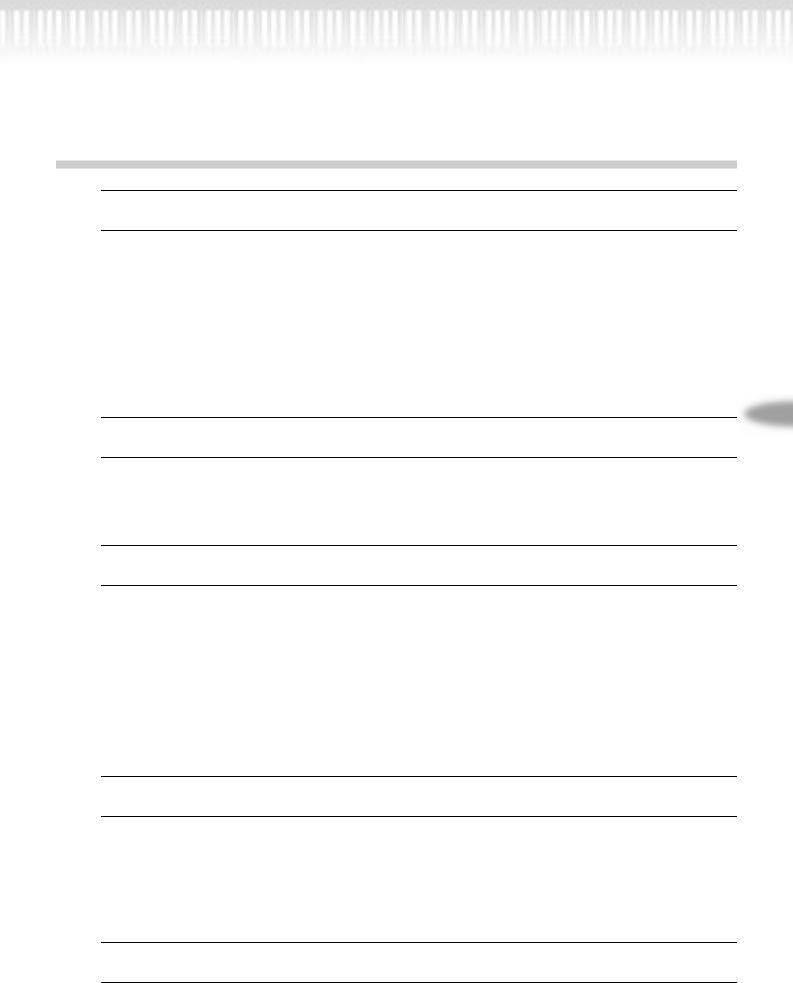
Application Index
Use this index to find reference pages that may be helpful for your application and situation.
Listening
Listening to demo songs............................................... |
“Listening to the Demonstration Tunes” on page 24 |
|
“Playing the 50 piano preset songs” on page 26 |
Listening to demo songs with different voices ............ |
“Listening to the Demonstration Tunes” on page 24 |
Listening to songs from “50 greats for the Clavinova” |
.......“Playing the 50 piano preset songs” on page 26 |
Listening to my recorded performance ............................................ |
“Recording to [TRACK 1]” on page 41 |
|
“Playing back a song” on page 57 |
Listening to songs in a floppy disk............................................................. |
“Playing back a song” on page 57 |
Playing
Using three pedals............................................................................................. |
“Using the pedals” on page 31 |
Playing an accompaniment that matches pitch ................... |
“Transposition ... [TRANSPOSE]” on page 34 |
Changing tonal color
Viewing the list of voices |
................................................................................ “Preset Voice List” on page 103 |
Simulating a concert hall |
...........................................................................................“[REVERB]” on page 33 |
Combining two voices ..................................................... |
“Combining two voices (Dual mode)” on page 35 |
Playing different sounds with left and right hands
........................... “Splitting the keyboard range and playing two different voices (Split mode)” on page 37
Making a voice brighter and sharper, or softer and smoother ........................ |
“[BRILLIANCE]” on page 32 |
Adding spread to the sound .................................................................................... |
“[CHORUS]” on page 33 |
Practicing
Muting the rightor left-hand part ........... |
“Practicing a one-hand part using 50 preset songs” on page 28 |
|
Practicing with an accurate and steady tempo |
.......................................“Using the metronome” on page 40 |
|
Practicing using your recorded song .......................................... |
|
“Recording Your Performance” on page 41 |
|
|
“Turning track playback on and off” on page 59 |
Recording
Recording your performance ...................................................... “Recording Your Performance” on page 41
Saving recorded songs to floppy disks or memory
...........................................................“Saving Recorded Songs and Handling the Files...[FILE]” on page 50
CLP-990 11
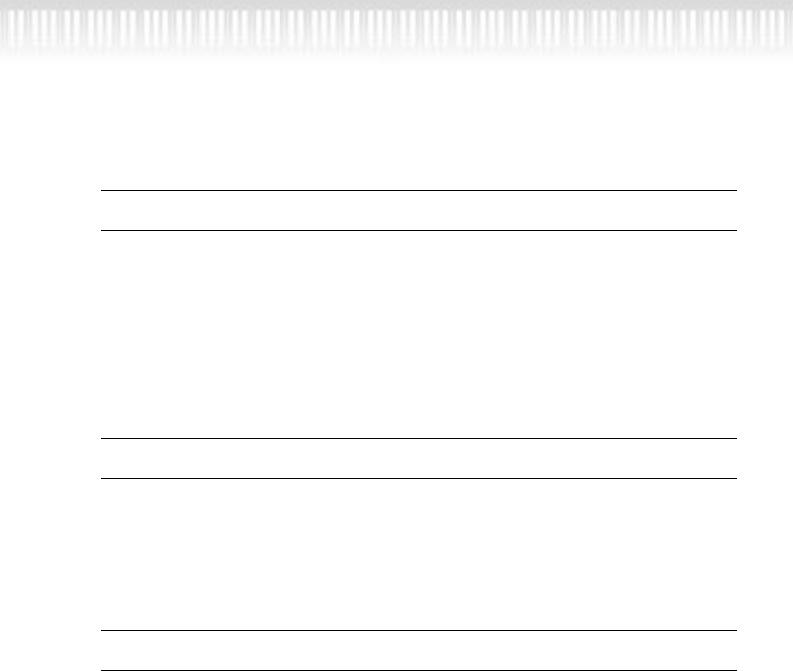
Application Index
Use this index to find reference pages that may be helpful for your application and situation.
Settings
Making detailed settings for recording and playback
............................................“Detailed settings for recording and playback [SONG SETTING]” on page 74
Making detailed settings for the metronome
......................................... “Detailed settings for the metronome METRONOME [SETTING]” on page 77
Making detailed settings for the voices
................................................................. “Detailed settings for the voices [VOICE SETTING]” on page 78
Making detailed settings for MIDI .................................................... |
“MIDI [MIDI SETTING]” on page 83 |
Making detailed settings for the Clavinova ......................................................... |
“Other settings” on page 87 |
Connecting the Clavinova to other devices
What is MIDI?..................................................................................... |
“MIDI [MIDI SETTING]” on page 83 |
Recording your performance ..................................................... |
“AUX OUT [R], [L/L+R] jacks” on page 61 |
Raising the volume ..................................................................... |
“AUX OUT [R], [L/L+R] jacks” on page 61 |
Outputting other instruments’ sound from the Clavinova .......... |
“AUX IN [R], [L/L+R] jacks” on page 62 |
Connecting a computer........................................................ |
“Connecting a personal computer” on page 63 |
Quick solution
What the Clavinova offers............................................................................. |
“Application Index” on page 11 |
|
“Features” on page 16 |
Returning to the main screen.............................................................................. |
“[EXIT] button” on page 23 |
Resetting the Clavinova to the default setting |
|
................................................................ |
“Restoring the normal (default) settings [FactorySet]” on page 91 |
Meaning of the messages........................................................................................ |
“Message List” on page 92 |
If you have questions about operations and functions |
|
.............................................................................. |
“Questions about Operations and Functions” on page 97 |
Troubleshooting............................................................................................. |
“Troubleshooting” on page 100 |
12 CLP-990

Handling the Floppy Disk
Drive(FDD) and Floppy Disk
Precautions
Be sure to handle floppy disks and treat the disk drive with care. Follow the important precautions below.
Compatible Disk Type
3.5" 2DD and 2HD type floppy disks can be used.
Inserting/Ejecting Floppy Disks
To insert a floppy disk into the disk drive:
Hold the disk so that the label of the disk is facing upward and the sliding shutter is facing forward, towards the disk slot. Carefully insert the disk into the slot, slowly pushing it all the way in until it clicks into place and the eject button pops out.
To eject a floppy disk:
Before ejecting the disk, be sure to confirm that the floppy disk drive is stopped. If the disk drive is operating (during the [SaveToDisk] (P53), [DeleteSong] (P53), [RenameSong] (P54), [CopyDisk] (P55), or [FormatDisk] (P56) operation), the Clavinova displays [Executing].
Never attempt to remove the disk or turn the power off when the disk drive is operating. Doing so can damage the disk and possibly the disk drive.
Press the eject button slowly as far as it will go; the disk will automatically pop out. When the disk is fully ejected, carefully remove it by hand.
Eject button
If the eject button is pressed too quickly, or if it is not pressed in as far as it will go, the disk may not eject properly. The eject button may become stuck in a half-pressed position with the disk extending from the drive slot by only a few millimeters. If this happens, do not attempt to pull out the partially ejected disk, since using force in this situation can damage the disk drive mechanism or the floppy disk. To remove a partially ejected disk, try pressing the eject button once again, or push the disk back into the slot and then repeat the eject procedure.
Be sure to remove the floppy disk from the disk drive before turning off the power. A floppy disk left in the drive for extended periods can easily pick up dust and dirt that can cause data read and write errors.
Cleaning the Disk Drive Read/Write Head
•Clean the read/write head regularly. This instrument employs a precision magnetic read/write head which, after an extended period of use, will pick up a layer of magnetic particles from the disks used that will eventually cause read and write errors.
•To maintain the disk drive in optimum working order Yamaha recommends that you use a commercially-avail- able dry-type head cleaning disk to clean the head about once a month. Ask your Yamaha dealer about the availability of proper head-cleaning disks.
•Never insert anything but floppy disks into the disk drive. Other objects may cause damage to the disk drive or floppy disks.
CLP-990 13
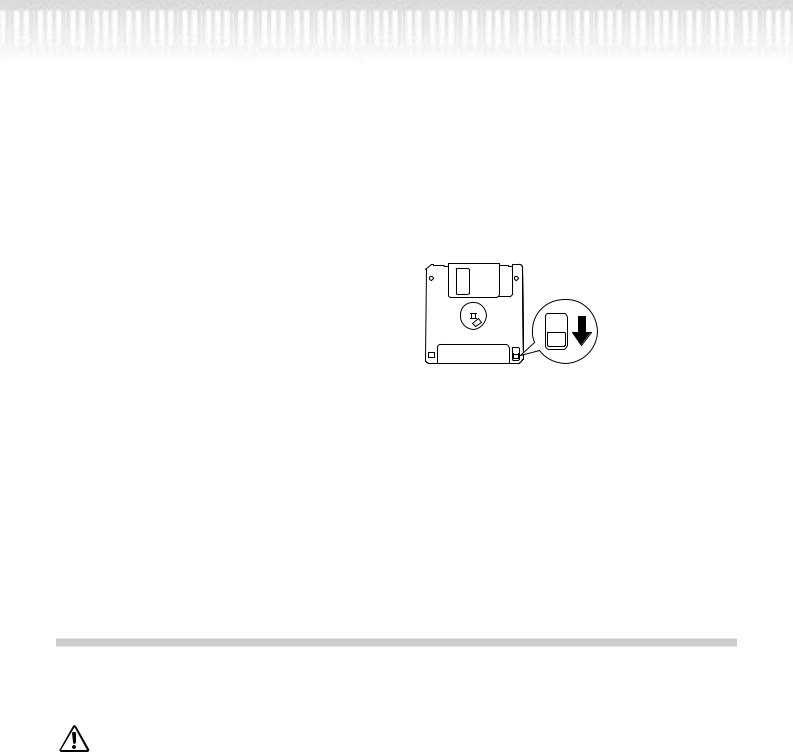
Handling the Floppy Disk Drive(FDD) and Floppy Disk
About the Floppy Disks
•To handle floppy disks with care:
•Do not place heavy objects on a disk or bend or apply pressure to the disk in any way. Always keep floppy disks in their protective cases when they are not in use.
•Do not expose the disk to direct sunlight, extremely high or low temperatures, or excessive humidity, dust or liquids.
•Do not open the sliding shutter and touch the exposed surface of the floppy disk inside.
•Do not expose the disk to magnetic fields, such as those produced by televisions, speakers, motors, etc., since magnetic fields can partially or completely erase data on the disk, rendering it unreadable.
•Never use a floppy disk with a deformed shutter or housing.
•Do not attach anything other than the provided labels to a floppy disk. Also make sure that labels are attached in the proper location.
•To protect your data (Write-protect Tab):
•To prevent accidental erasure of important data, slide the disk’s write-protect tab to the “protect” position (tab open).
write-protect tab open (protect position)
•Data backup
•For maximum data security Yamaha recommends that you keep two copies of important data on separate floppy disks. This gives you a backup if one disk is lost or damaged. To make a backup disk use the Copy Disk function on page 55.
Maintenance
Clean the instrument using a dry, soft cloth or slightly damp, soft cloth (wring well).
Do not use benzine, thinner, detergent, or chemical cloth for cleaning. Do not place vinyl, plastic, or rubber products on the instrument.
Otherwise, the panel or keys may be discolored or degraded.
Before using the Clavinova, be sure to read “Precautions” on pages 3-5.
Tuning
Unlike an acoustic piano, the Clavinova does not need to be tuned. It always stays perfectly in tune.
Transporting
If you move to another location, you can transport the Clavinova along with other stuff. You can move the unit as it is (assembled) or you can disassemble the unit down to the condition when you first open the package. Transport the keyboard horizontally. Do not lean it to the wall and the like.
14 CLP-990
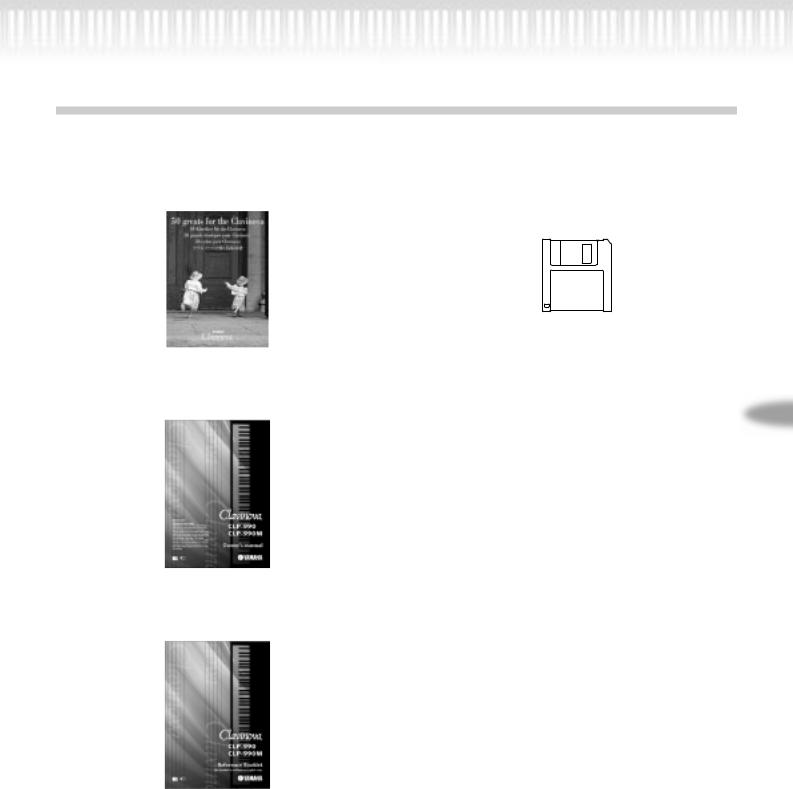
Included Accessories
“50 greats for the Clavinova” Score Collection |
Recording disk |
|
Save your recorded performance to this disk. (page 53) |
Bench
(included or optional depending on locale)
Owner’s Manual
Reference Booklet
CLP-990 15
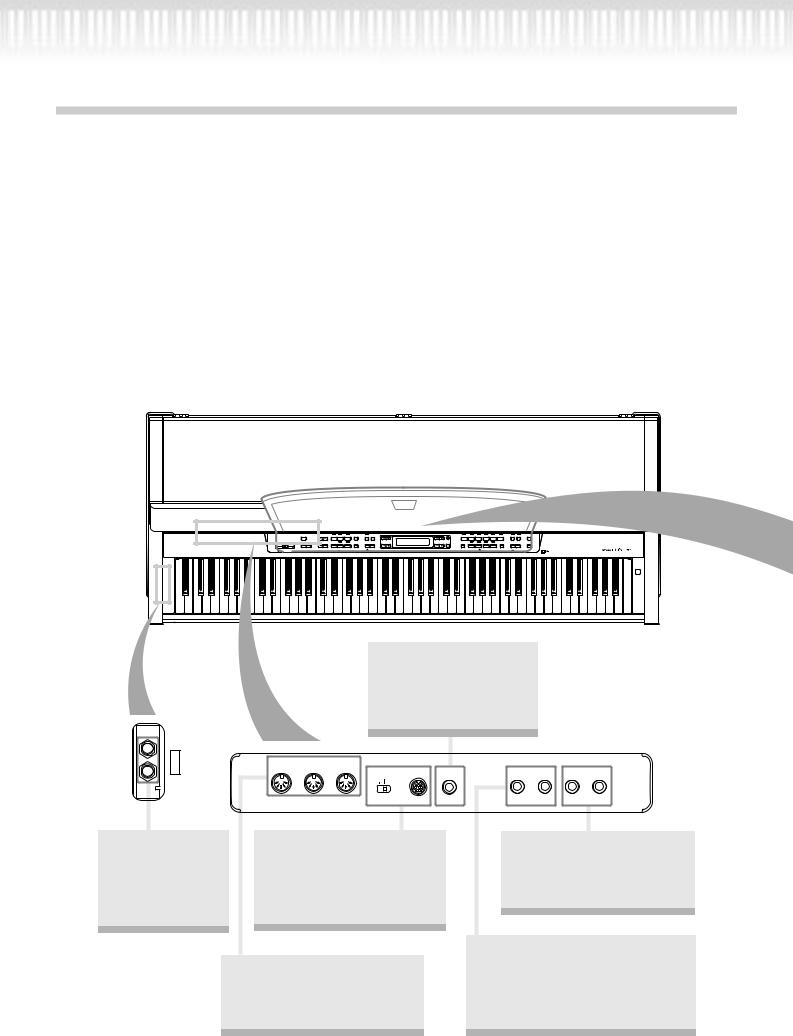
Features
The Yamaha Clavinova CLP-990 digital piano offers unmatched sonic realism and natural grand-piano type playability as well as Yamaha’s original “AWM Dynamic Stereo Sampling” tone generation technology for rich, musical voices, and a special “NL Keyboard (Natural Keyboard)” that uses wooden keys with a new action mechanism for improved continuous key response. The CLP-990 GrandPiano1 voice features totally new samples painstakingly recorded from each key of a full concert grand piano. The CLP-990 GrandPiano1 voice features five velocityswitched samples (Dynamic Sampling), a “Soundboard Reverb” (page 33) effect that accurately simulates the resonance of a piano soundboard, “String Resonance” (page 88) that recreates resonance of piano strings, special “Sustain Sampling” (page 88)that samples the unique resonance of an acoustic grand piano’s soundboard and strings when the damper pedal is pressed, and “Key-off Samples” that add the subtle sound produced when the keys are released. The CLP-990 comes much closer to the sound of a true acoustic piano.
CLP-970
PHONES
A set of standard stereo headphones can be plugged in here for private practice. (page 20)
Connect an optional pedal here and assign one of the various functions to the pedal. (page 62)
IN 




 OUT
OUT




 THRU
THRU
|
PC-2 PC-1 |
|
|
|
MIDI |
Mac |
|
MIDI |
HOST SELECT |
TO HOST AUX PEDAL |
|
This jack and selector switch allow direct connection to a personal computer for sequencing and other music applications. (page 62-67)
Connect a MIDI device here to use various MIDI functions. (page 63, 66)
(About MIDI—page 83)
L/L+R 


 R L/L+R
R L/L+R 


 R
R
AUX IN AUX OUT
Connect recording equipment (such as a cassette tape recorder) here to record your performance. (page 61)
These jacks allow you to connect an external tone generator to reproduce the sound via the Clavinova’s internal sound system and speakers. (page 62)
16 CLP-990
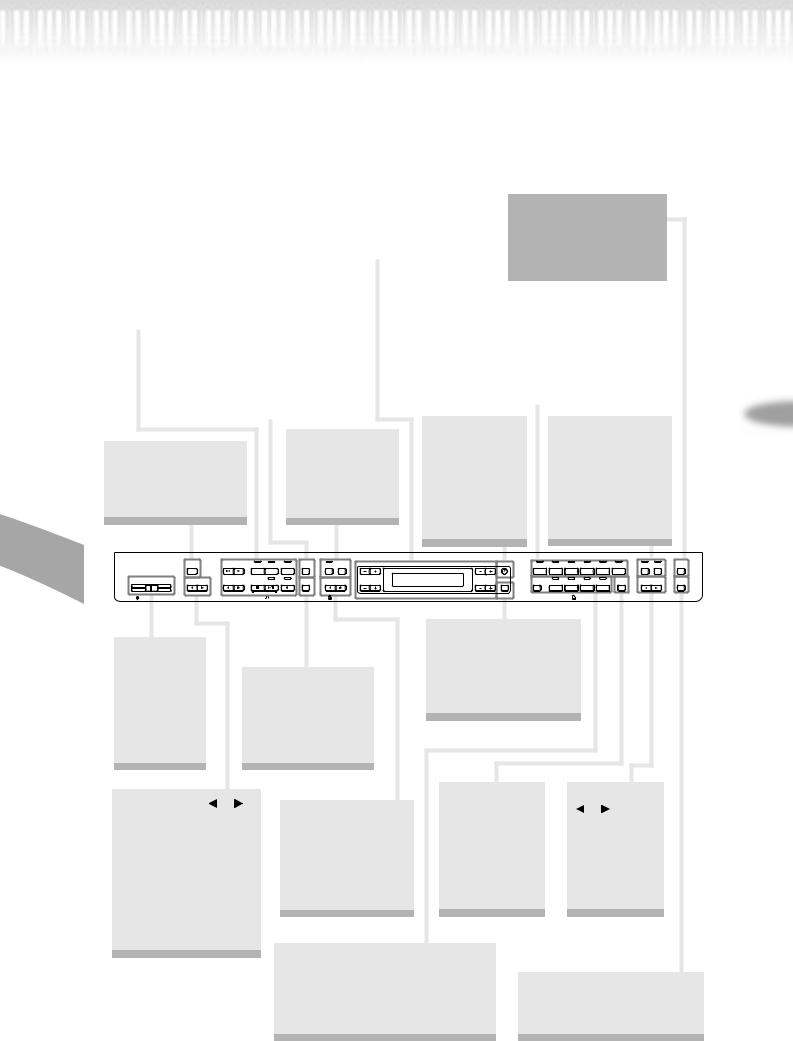
Features
The Clavinova includes 50 preset |
|
|
The display allows |
|
[MIDI SETTING] |
|||
|
accurate control |
|||||||
songs. |
|
|
||||||
|
|
|
Make detailed MIDI |
|||||
This section enables you to listen to |
|
|
and operation. |
|
settings, such as MIDI |
|||
these songs, practice using a |
|
|
(page 23) |
|
receive/transmit |
|||
convenient practice function, play back |
|
|
|
|
|
channels. (page 83) |
||
|
|
|
||||||
Clavinova music data (sold in music |
|
|
|
|
|
|
|
|
|
|
|
|
|
|
|||
stores), and record and play back your |
|
|
|
|
|
|
|
|
performance. (page 26, 41, 57) |
|
|
|
MAIN voice gruop buttons |
|
|||
|
|
|
|
|
|
|||
|
|
|
|
|
Select voices from 25 internal sounds |
|
||
|
|
|
|
|
|
|||
|
|
|
|
|
including Grand Piano 1. (page 30) |
|
||
|
[FILE] |
|||||||
|
|
|
You can also combine two voices at a |
|
||||
|
Save recorded songs and |
|
|
time. (page 35) |
|
|
|
|
|
manage song files. (page 50) |
|
|
|
|
|
|
|
|
|
|
|
|
|
|
|
|
|
|
|
|
|
|
|
|
|
|
|
|
|
|
|
|
|
|
|
[METRONOME] |
[CONTRAST] |
[REVERB]/ |
|
[DEMO] |
Adjust the |
[CHORUS] |
||
Use the |
brightness of |
Add reverb |
||
Demonstration playback |
||||
metronome |
the display |
(reverberation) and |
||
is available for each |
||||
functions. |
using this |
spread (chorus) to |
||
voice. (page 24) |
||||
(page 40) |
control. |
the sound. |
||
|
||||
|
|
(page 20) |
(page 33) |
CLP-990 |
|
DEMO |
SONG SELECT |
TRACK |
TRACK |
EXTRA |
FILE |
METRONOME |
A |
|
|
|
|
1 |
2 |
TRACKS |
|
START/STOP SETTING |
|
|
|
|
NEW SONG |
|
|
|
|
|
|
MIN |
MAX |
TRANSPOSE |
SONG BALANCE |
STOP |
START/ |
REC |
SONG |
DOWN UP |
|
|
|
|
|
|
PAUSE |
|
SETTING |
|
|
B |
CONTRAST |
PIANO |
E. PIANO/ |
HARPSI- |
MALLET |
ORGAN |
STRINGS/ |
|
|
|
BASS |
CHORD |
|
|
CHOIR |
|
|
MAIN |
|
|
|
|
|
NO |
YES |
|
|
|
|
|
|
|
|
SPLIT |
PIANO/ |
HARPSI/ |
ORGAN/ |
BASS |
VOICE |
|
|
POINT |
E. PIANO |
MALLET |
STRINGS |
|
SETTING |
|
EXIT |
LEFT |
|
|
|
|
|
REVERB CHORUS |
MIDI |
|
SETTING |
BRILLIANCE |
OTHER |
|
SETTING |
|
SYNCHROSTART |
C |
D |
|
|
|
|
MASTER VOLUME |
SONG |
|
VOICE |
EFFECT |
|||
TEMPO |
|
|
|||||
|
|
|
[EXIT] |
|
|
|
|
[MASTER |
|
|
The screen returns to |
|
|
||
VOLUME] |
|
|
its main display when |
|
|
||
Adjust the |
[SONG SETTING] |
you press this button. |
|
|
|||
volume level |
Make detailed |
(page 23) |
|
|
|
||
using this |
settings for song |
|
|
|
|
||
slider. |
recording and |
|
|
|
|
||
(page 20) |
playback. (page 74) |
|
|
|
|
||
TRANSPOSE [ |
] [ ] |
|
[VOICE |
|
BRILLIANCE |
||
TEMPO [DOWN] |
SETTING] |
|
[ |
] [ ] |
|||
You can shift the pitch |
|
||||||
You can make |
Adjust the |
||||||
[UP] |
|||||||
of the entire keyboard |
|||||||
detailed settings |
brightness of |
||||||
You can change the |
|||||||
up or down so that the |
|||||||
for tone and |
|
the tone using |
|||||
song tempo |
|
||||||
pitch will match that of |
|
||||||
effects. |
|
these buttons. |
|||||
(speed). |
|
||||||
another instrument or |
|
||||||
(page 78) |
|
(page 32) |
|||||
(page 27, 40, 42, 58) |
|
||||||
singer, while you play |
|
||||||
|
|
|
|
||||
|
|
|
|
|
|||
the same keys. |
|
|
|
|
|
|
|
(page 34) |
|
|
|
|
|
|
|
|
|
LEFT voice group buttons/ |
|
|
|
||
|
|
[SPLIT POINT] |
|
[OTHER SETTING] |
|||
|
|
You can play different voices on |
|||||
|
|
the leftand right-hand sections of |
Fine-tune the touch response |
||||
|
|
the keyboard. (page 37) |
|
and pitch, etc. (page 87) |
|||
CLP-990 17
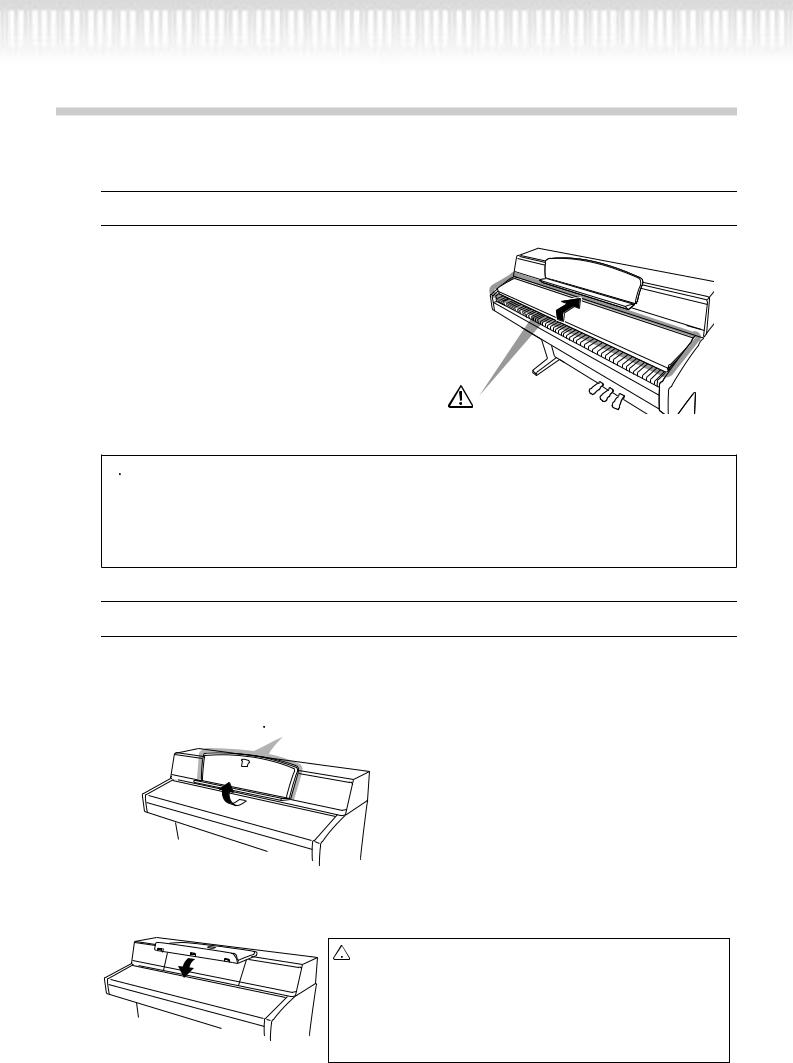
Before Using the Clavinova
Key cover
To open the key cover:
Lift the cover slightly, then push and slide it open.
To close the key cover:
Slide the cover toward you and gently lower the cover over the keys.
Be careful to avoid catching your fingers when opening or closing the cover.
 CAUTION
CAUTION
Hold the cover with both hands when opening or closing it. Do not release it until it is fully opened or closed. Be careful to avoid catching fingers (yours or others, especially children’s between the cover and the unit.
Do not place objects such as a piece of metal or paper on top of the key cover. Small objects placed on the key cover may fall inside the unit when the cover is opened and may be nearly impossible to remove. This could cause electric shock, short circuit, fire or other serious damage to the instrument.
Adjusting the music stand angle
Changing the angle
Grasp the bottom of the stand and lift the stand while pulling it toward you. The stand locks at various angles when you hear a click .
 Be careful not to pinch your fngers!
Be careful not to pinch your fngers!
Replacing the stand to its original position
Raise the bottom of the stand until the stand becomes horizontal. Then lower the stand while supporting the bottom.
 • When you adjust the music stand angle, be sure to hold the bottom part, not the upper part or the sides. Use caution not to pinch anyone’s fingers, especially those of young children, between the stand and the unit.
• When you adjust the music stand angle, be sure to hold the bottom part, not the upper part or the sides. Use caution not to pinch anyone’s fingers, especially those of young children, between the stand and the unit.
•Do not adjust the angle with sheet music or other objects resting on the stand. Otherwise, the objects may fall and cause injury.
•Do not place heavy objects on the music stand. Doing so may damage the music stand, or may cause injury.
18 CLP-990
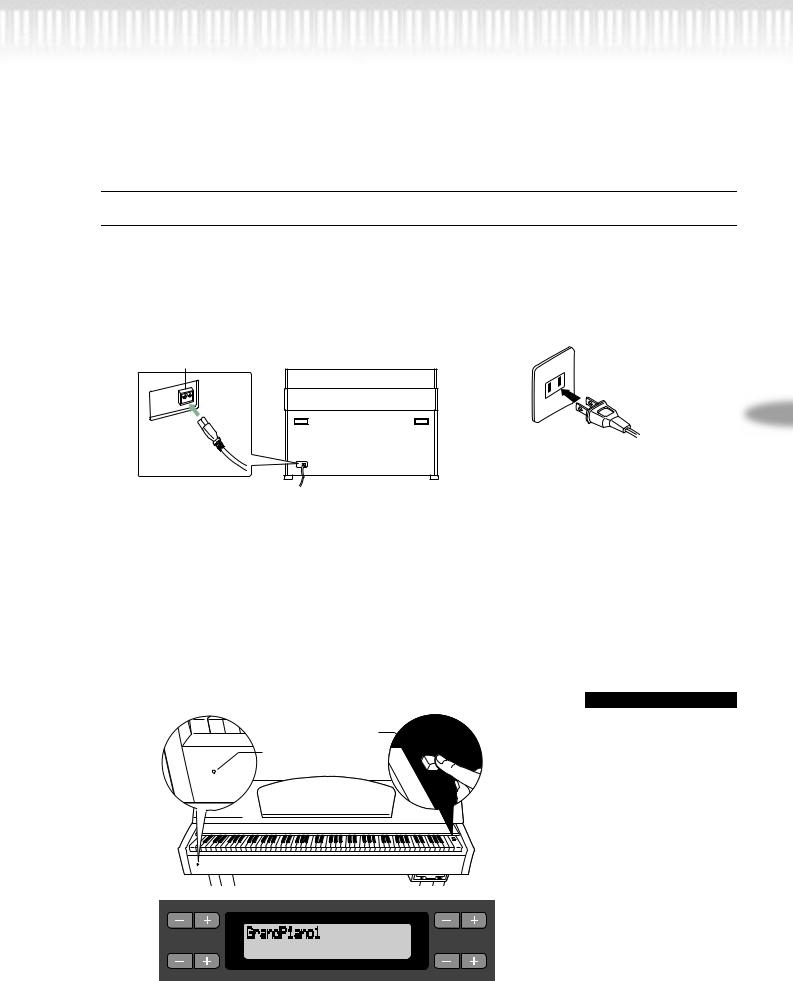
Before Using the Clavinova
Turning the power on
1.Connect the power cable.
First insert the plug of the power cable into the AC connector on the Clavinova, then plug the other end of the cable into the proper AC outlet on the wall.
In some areas a plug adaptor may be provided to match the pin configuration of the AC wall outlets in your area.
1 |
The power connector is located on the lower part of the |
2 |
rear panel. |
(The shape of plug differs depending on locale.)
WARNING!
Make sure your CLP-990 is rated for the AC voltage supplied in the area in which it is to be used (voltage rating appears on the name plate on the bottom panel). In some areas, a voltage selector may be provided on the bottom panel of the main keyboard unit near the power cord. Make sure that the voltage selector is set for the voltage in your area. Connecting the unit to the wrong AC supply can cause serious damage to the internal circuitry and may even pose a shock hazard!
Use only the AC power cord supplied with the CLP-990. If the supplied cord is lost or damaged and needs to be replaced, contact your Yamaha dealer. The use of an inappropriate replacement can pose a fire and shock hazard!
The type of AC power cord provided with the CLP-990 may be different depending on the country in which it is purchased. (In some areas a plug adaptor may be provided to match the pin configuration of the AC wall outlets in your area.) Do NOT modify the plug provided with the CLP-990. If the plug will not fit the outlet, have a proper outlet installed by a qualified electrician.
2. Turn on the power to the Clavinova.
Press the [POWER] switch located on the right of the keyboard to turn the power on. |
|
• The screen located in the center of the front panel and the power indica- |
|
tor located below the left end of the keyboard lights up. |
TIP |
[POWER] switch
Power indicator
Power indicator
If you close the key cover without turning the power off, the power indicator remains lit, indicating that the power is still on.
A B
NO |
YES |
C |
D |
When you turn on the power to the Clavinova, a voice name appears on the screen.
Press the [POWER] switch again to turn off the power to the Clavinova.
• The screen and the power indicator turn off.
CLP-990 19
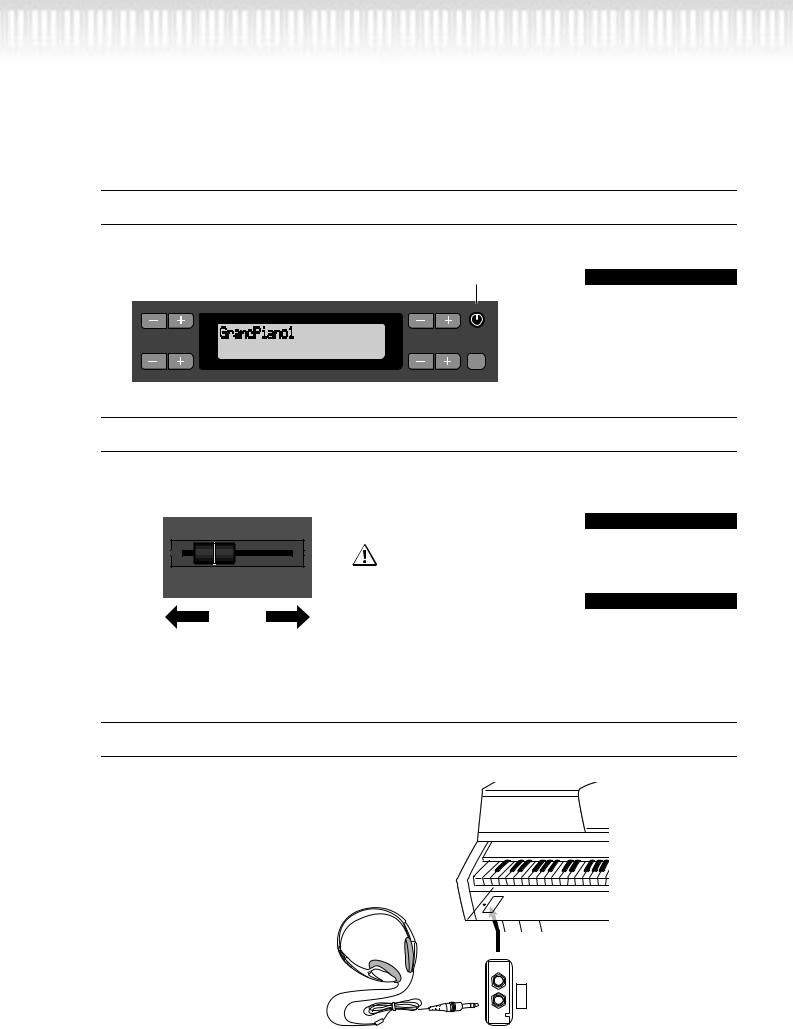
Before Using the Clavinova
Adjusting the display contrast
You can adjust the contrast of the display by turning the [CONTRAST] knob located to the right of the LCD.
Use this knob.
A |
B |
CONTRAST |
NO |
YES |
|
EXIT |
C |
D |
TERMINOLOGY
CONTRAST:
difference between brightness and darkness
Setting the volume
While playing the keyboard, adjust the volume level by moving the [MASTER VOLUME] slider on the left of the front panel to the left or right.
MIN 







 MAX
MAX

 MASTER VOLUME
MASTER VOLUME
The level decreases. |
The level increases. |
Do not use the Clavinova at a high volume level for a long period of time, or your hearing may be damaged.
TERMINOLOGY
MASTER VOLUME:
The volume level of the entire keyboard sound
TIP
You can also adjust the [PHONES] output level and the AUX IN input level using the [MASTER VOLUME] slider.
Using headphones
Connect a pair of headphones to one of the [PHONES] jacks. When the headphones are plugged into either of the [PHONES] jacks, the internal speaker system is automatically shut off.
Two [PHONES] jacks are provided. Two sets of standard stereo headphones can be plugged in. (If you are using only one pair of headphones, you can plug them into either of these jacks.)
bottom surface |
||
|
|
|
|
TIP |
|
PHONES |
Optional headphones |
|
HPE-160 Yamaha head- |
||
|
||
phones.
standard stereo phone plug
20 CLP-990
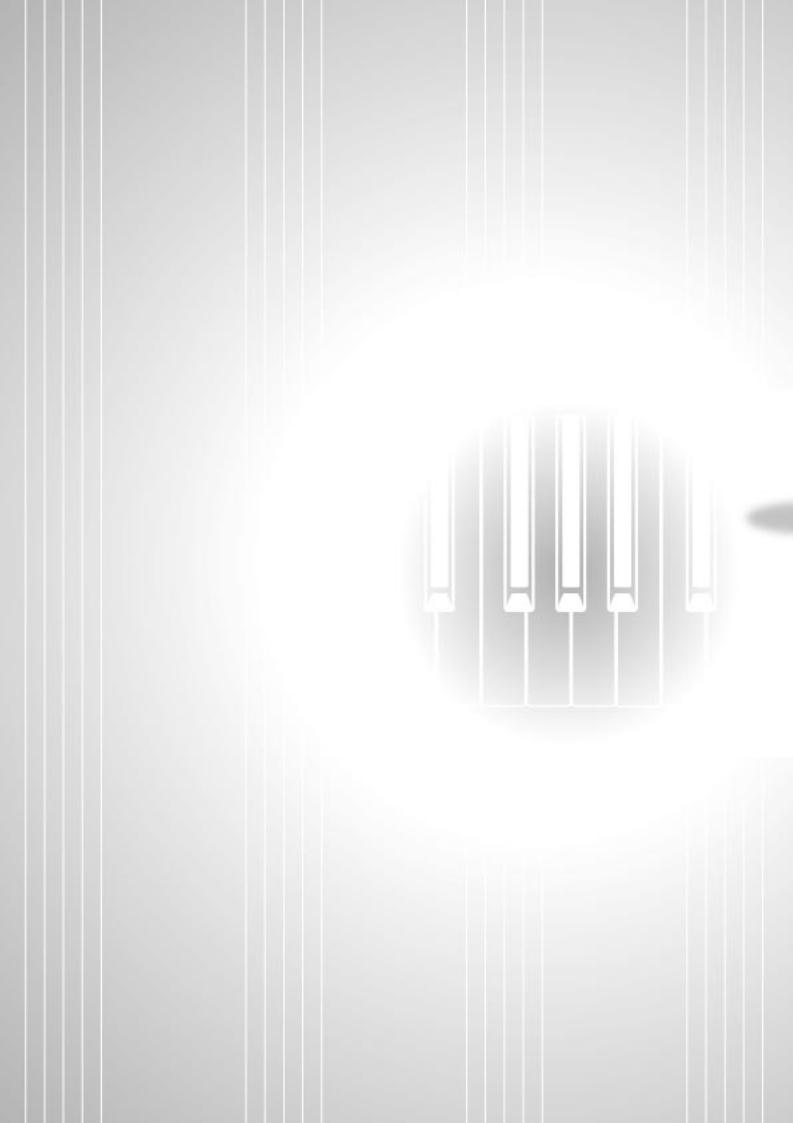
Basic Operation
CLP-990 21
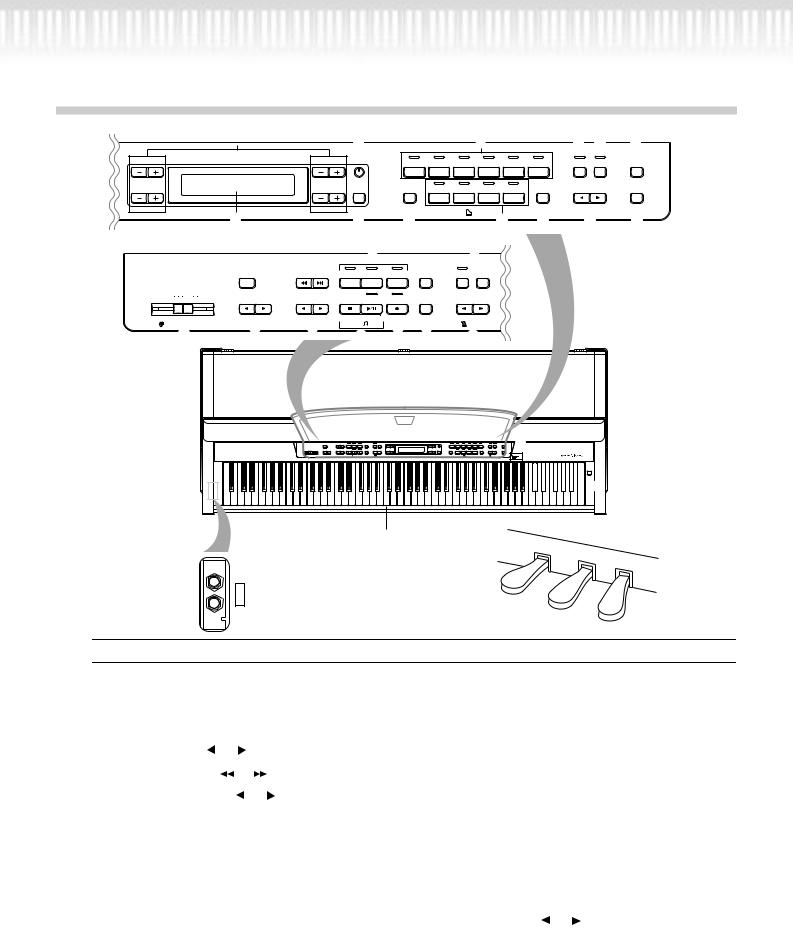
Part Names
|
|
D |
|
F |
|
|
|
|
H |
|
|
|
L M |
O |
|
|
|
|
|
|
|
|
|
|
|
||||
A |
|
|
B |
CONTRAST |
PIANO E. PIANO/ |
HARPSI- |
MALLET |
ORGAN |
STRINGS/ |
REVERB CHORUS |
MIDI |
|||
|
|
|
|
|
|
|
BASS |
CHORD |
|
|
|
CHOIR |
|
SETTING |
|
|
|
|
|
|
MAIN |
|
|
|
|
|
|
|
|
|
|
|
NO |
YES |
|
|
|
|
|
|
|
|
|
|
|
|
|
|
|
|
SPLIT |
PIANO/ |
HARPSI/ |
ORGAN/ |
BASS |
VOICE |
BRILLIANCE |
OTHER |
|
|
|
|
|
|
|
POINT |
E. PIANO |
MALLET |
STRINGS |
|
SETTING |
|
SETTING |
|
|
|
|
|
EXIT |
|
LEFT |
|
|
|
|
|
|
|
|
C |
|
|
D |
|
|
|
|
|
VOICE |
|
|
|
EFFECT |
|
|
|
|
|
|
|
|
|
|
|
|
|
|
||
|
|
E |
|
G |
|
I |
|
|
|
J |
K |
N |
P |
|
|
|
3 |
5 |
|
7 |
|
8 |
B |
|
|
|
|
|
|
|
|
|
|
|
|
|
|
|
|
|
|
|||
CLP-990 |
|
DEMO |
SONG SELECT |
TRACK |
TRACK |
EXTRA |
FILE |
METRONOME |
|
|
|
|
|
|
|
|
|
|
1 |
2 |
TRACKS |
|
START/STOP SETTING |
|
|
|
|
|
|
|
|
|
NEW SONG |
|
|
|
|
|
|
|
|
|
|
|
MIN |
MAX |
TRANSPOSE |
SONG BALANCE |
STOP |
START/ |
REC |
SONG |
DOWN |
UP |
|
|
|
|
|
|
|
|
|
|
PAUSE |
|
SETTING |
|
|
|
|
|
|
|
|
2 |
4 |
6 |
SYNCHROSTART |
0 A |
C |
|
|
|
|
|
|||
|
9 |
|
|
|
|
|
||||||||
|
MASTER VOLUME |
|
|
|
SONG |
|
|
TEMPO |
|
|
|
|
|
|
]



 1
1
A-1B-1 C0 D0 E0 F0 G0 A0 B0 C1 D1 E1 F1 G1 A1 B1 C2 D2 E2 F2 G2 A2 B2 C3 D3 E3 F3 G3 A3 B3 C4 D4 E4 F4 G4 A4 B4 C5 D5 E5 F5 G5 A5 B5 C6 D6 E6 F6 G6 A6 B6 C7
Center “C”
PHONES
Q
R
S
T
Top panel
1 |
[POWER].............................................. |
P19 |
2 |
[MASTER VOLUME]............................. |
P20 |
3 |
[DEMO] ............................................... |
P24 |
4TRANSPOSE [ ] [ |
] .......................... |
|
|
P34 |
||
5SONG SELECT [ |
|
] [ |
|
] |
P26, 41, 57 |
|
|
|
|||||
6SONG BALANCE [ |
] [ |
].................... |
P48 |
|||
7 |
[TRACK1] [TRACK2] / |
|
|
|
||
|
[EXTRA TRACKS] ............... |
|
|
|
P28, 41–46, 59 |
|
8 |
[FILE] ................................................... |
|
|
|
P50 |
|
9SONG [STOP] / |
|
|
|
|
||
|
[START/PAUSE] ....................... |
|
|
|
P26, 42, 58 |
|
0 |
[REC].................................................... |
|
|
|
P42 |
|
A[SONG SETTING] ................................ |
|
|
|
P74 |
||
BMETRONOME [START/STOP] / |
||||||
|
[SETTING]...................................... |
|
|
|
P40, 77 |
|
CTEMPO [DOWN] [UP] ....... |
|
|
P27, 40, 42, 58 |
|||
DLCD buttons A [–] [+] / B [– (NO)] [+ (YES)] /
C [–] [+] / D [–] [+]............................... |
P23 |
ELCD screen .......................................... |
P23 |
F[CONTRAST] knob............................... |
P20 |
G[EXIT]................................................... |
P23 |
HVoice group buttons for the MAIN |
|
section ................................................. |
P30 |
I[SPLIT POINT] ..................................... |
P38 |
JVoice group buttons for the LEFT |
|
section ................................................. |
P37 |
K[VOICE SETTING] ................................ |
P78 |
L[REVERB].............................................. |
P33 |
M[CHORUS]............................................ |
P33 |
NBRILLIANCE [ ] [ ] ........................... |
P32 |
O[MIDI SETTING]................................... |
P83 |
P[OTHER SETTING] ............................... |
P87 |
Q[PHONES] ............................................ |
P20 |
RSoft pedal............................................ |
P31 |
SSostenuto pedal .................................. |
P31 |
TDamper pedal ..................................... |
P31 |
22 CLP-990
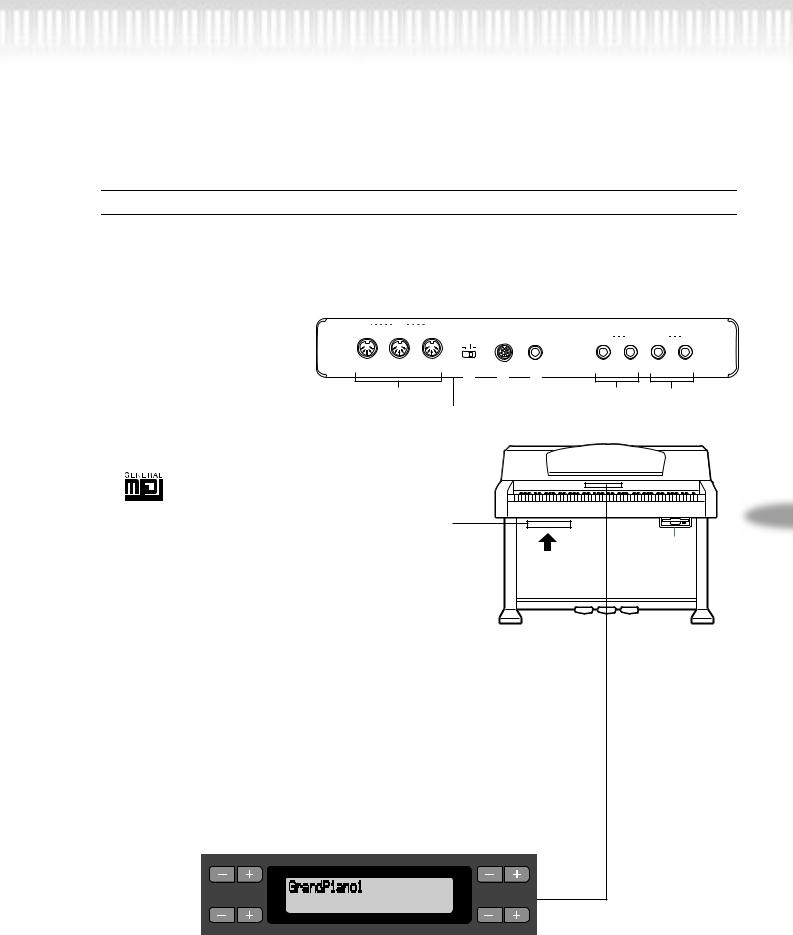
Part Names
Connectors
UAUX OUT [R] [L/L+R].......................... |
P61 |
YHOST SELECT ..................................... |
|
P62 |
||
VAUX IN [R] [L/L+R] ............................. |
P62 |
ZMIDI [IN] [OUT] [THRU] .................... |
P63 |
|||
W[AUX PEDAL] ...................................... |
P62 |
|
|
|
|
|
X[TO HOST] .......................................... |
P62 |
|
|
|
|
|
IN |
OUT |
THRU |
|
|
|
|
|
|
|
|
L/L+R |
R |
L/L+R R |
|
|
PC-2 PC-1 |
|
|
|
|
|
|
MIDI Mac |
|
|
|
|
|
MIDI |
HOST SELECT |
TO HOST |
AUX PEDAL |
AUX IN |
AUX OUT |
|
|
Y |
X |
W |
|
|
|
Z |
|
|
|
V |
U |
\Floppy disk drive................................. |
P13 |
|
|
|
|
|
]Panel logos |
|
|
|
|
|
|
GM System Level 1 |
|
|
|
|
|
|
“GM System Level 1” is an addition to the MIDI |
|
|
|
|
|
|
standard which guarantees that any data conform- |
|
|
|
|
|
|
ing to the standard will play accurately on any |
|
|
uppee left |
|
\ |
|
GM-compatible tone generator or synthesizer |
|
|
|
|
||
|
|
on the front |
|
|
||
from any manufacturer. |
|
|
|
|
|
|
|
|
|
board |
|
|
|
 XG Format
XG Format
XG is a new Yamaha MIDI specification which significantly expands and improves on the “GM System Level 1” standard with greater voice handling capacity, expressive control, and effect capability while retaining full compatibility with GM.
DLCD buttons
ELCD
Use the LCD button A, B, C, or D to select the contents displayed on the LCD. Check the screen located in the center of the top panel after every operation. A voice name appears on the screen when you turn on the power to the unit.
A B
NO |
YES |
C |
D |
G[EXIT] button
When you press this button, the unit returns to the default screen (the screen that indicates a voice name(s) and is displayed when the power is turned on).
CLP-990 23
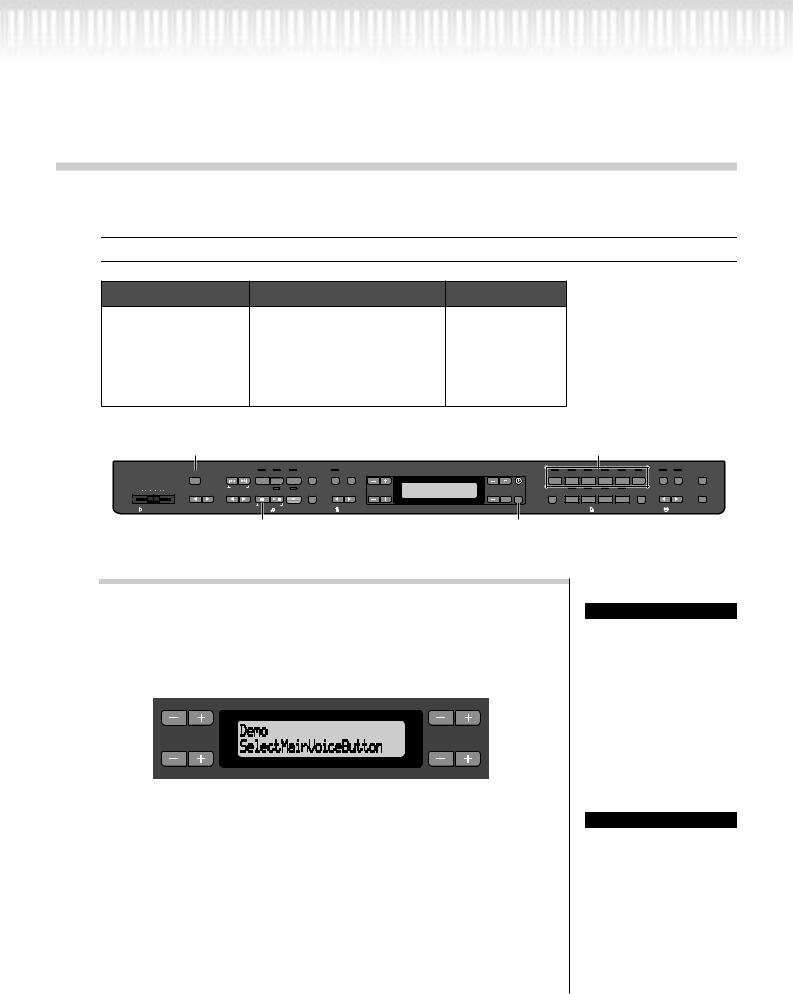
Listening to the Demonstration Tunes
The Clavinova provides demonstration tunes that effectively demonstrate each of the MAIN voice groups. Refer to the table below for voice names and corresponding demo songs.
Demonstration tunes
Voice group |
|
|
Tunes |
|
Composer |
|
|
|
|
PIANO |
|
Chanson de l’adieu |
|
F.F. Chopin |
|
|
|
||
E.PIANO/BASS |
Original |
|
|
– |
|
|
|
||
HARPSICHORD |
Le Coucou |
|
|
L.C. Daguin |
|
|
|
||
MALLET |
|
Original |
|
|
– |
|
|
|
|
ORGAN |
|
Organ Concerto Op.4 No.2 |
G.F. Händel |
|
|
|
|||
STRINGS/CHOIR |
Original |
|
|
– |
|
|
|
||
|
1 4 |
|
|
|
|
|
2 3 |
MAIN voice |
|
|
|
|
|
|
|
group buttons |
|||
CLP-990 |
DEMO |
SONG SELECT TRACK TRACK |
EXTRA FILE |
METRONOME |
A |
B CONTRAST |
PIANO E. PIANO/ HARPSIMALLET ORGAN STRINGS/ REVERB CHORUS |
MIDI |
|
|
|
1 2 |
TRACKS |
START/ STOP SETTING |
|
|
BASS CHORD |
CHOIR |
SETTING |
|
|
MAIN |
NEW SONG |
NO |
YES |
MIN |
MAX |
TRANSPOSE |
SONG BALANCE |
STOP START/ |
REC |
SONG |
DOWN UP |
SPLIT |
PIANO/ |
HARPSI/ |
ORGAN/ BASS |
VOICE |
BRILLIANCE |
OTHER |
|
|
|
|
PAUSE |
|
SETTING |
|
POINT |
E. PIANO |
MALLET |
STRINGS |
SETTING |
|
SETTING |
EXIT |
LEFT |
|
SYNCHRO START |
C |
D |
|
MASTER VOLUME |
SONG |
TEMPO |
VOICE |
EFFECT |
3 |
4 |
Procedure
1. Engage the demo mode.
Press the [DEMO] button to engage the demo mode.
The MAIN voice group (upper row) button indicators light up in sequence.
A B
NO YES
C |
D |
2. Select a tune and start playback.
Press the voice group button (upper row) of the desired demonstration tune.
The corresponding voice button indicator lights up and playback starts. Until you stop playback, the selected tune will be played repeatedly using different voices (in the following order: PIANO → E. PIANO/BASS → HARPSICHORD → MALLET → ORGAN → STRINGS/CHOIR).
TERMINOLOGY
Mode:
A mode is a status under which you can execute a certain function. In demo mode, you can play back demonstration tunes.
NOTE
To adjust the volume level of the demo songs, use the [MASTER VOLUME] slider.
24 CLP-990

Listening to the Demonstration Tunes
3.
4.
Stop the playback.
Press the button of the voice group being played or the [STOP] button.
Exit from demo mode.
Press the [DEMO] or [EXIT] button to exit from demo mode.
CLP-990 25
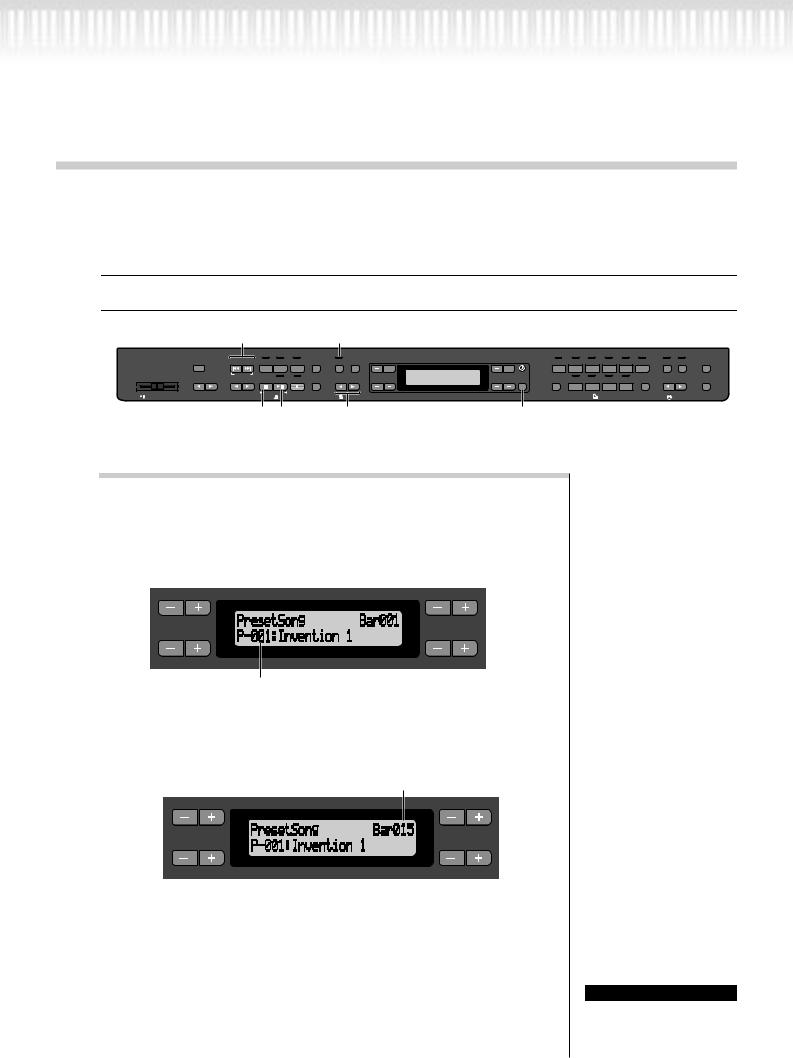
Listening to 50 Piano Preset Songs
The Clavinova provides performance data of 50 piano songs. You can just listen to these songs (page 26) or use them for practice (page 28). You can also refer to the included “50 greats for the Clavinova” that contains the scores for 50 piano preset songs.
Playing the 50 piano preset songs
1 METRONOME [START/STOP]
CLP-990 |
DEMO |
SONG SELECT |
TRACK |
TRACK |
EXTRA |
FILE |
METRONOME |
A |
B |
CONTRAST |
PIANO E. PIANO/ |
HARPSI- |
MALLET ORGAN STRINGS/ |
REVERB CHORUS |
MIDI |
|
|
|
1 |
2 |
TRACKS |
|
START/ STOP SETTING |
|
|
|
BASS |
CHORD |
CHOIR |
|
SETTING |
|
|
MAIN |
NEW SONG |
NO |
YES |
MIN |
MAX |
TRANSPOSE |
SONG BALANCE |
STOP START/ |
REC |
SONG |
DOWN UP |
SPLIT |
PIANO/ |
HARPSI/ |
ORGAN/ BASS |
VOICE |
BRILLIANCE |
OTHER |
|
|
|
|
PAUSE |
|
SETTING |
|
POINT |
E. PIANO |
MALLET |
STRINGS |
SETTING |
|
SETTING |
EXIT |
LEFT |
|
SYNCHRO START |
C |
D |
|
MASTER VOLUME |
SONG |
TEMPO |
VOICE |
EFFECT |
3 2 |
TEMPO [DOWN] [UP] |
4 |
|
|
Procedure
1.
2.
Select a song. |
|
|
TERMINOLOGY |
|||
Press one of the [SONG SELECT] buttons repeatedly to |
Song: |
|||||
On the Clavinova, perfor- |
||||||
select the desired piano song from P-001 to P-050. |
||||||
mance data is called a |
||||||
Song select screen |
|
|
“Song.” This includes dem- |
|||
|
|
onstration tunes and piano |
||||
|
|
|
|
|
||
|
A |
|
B |
|
preset tunes. |
|
NO |
YES |
C |
D |
The song number appears on the display.
Play a preset song. |
TIP |
Press the [START/PAUSE] button to start playback. |
• You can also use the C |
|||
|
[–]/[+] buttons to select a |
|||
|
|
|
||
the number of measures |
|
song after pressing the |
||
|
[SONG SELECT] button. |
|||
A |
B |
|
||
• |
[P-000: NewSong] is a |
|||
|
|
|||
NO |
YES |
|
blank song provided for |
|
|
you to record your perfor- |
|||
|
|
|
||
|
|
|
mance. (See page 41.) |
|
C |
D |
• |
Use the SongRepeat |
|
|
parameter in the “SONG |
|||
|
|
|
||
|
|
|
SETTING” menu to |
|
|
|
|
select repeat playback of |
|
|
|
|
all songs or repeat play- |
|
|
|
|
back of a single song. |
|
|
|
|
(See page 76.) |
|
|
|
|
TIP |
|
|
|
You can play the keyboard |
||
|
|
along with the preset song |
||
|
|
playback.You can change the |
||
|
|
voice playing on the keyboard. |
||
26 CLP-990
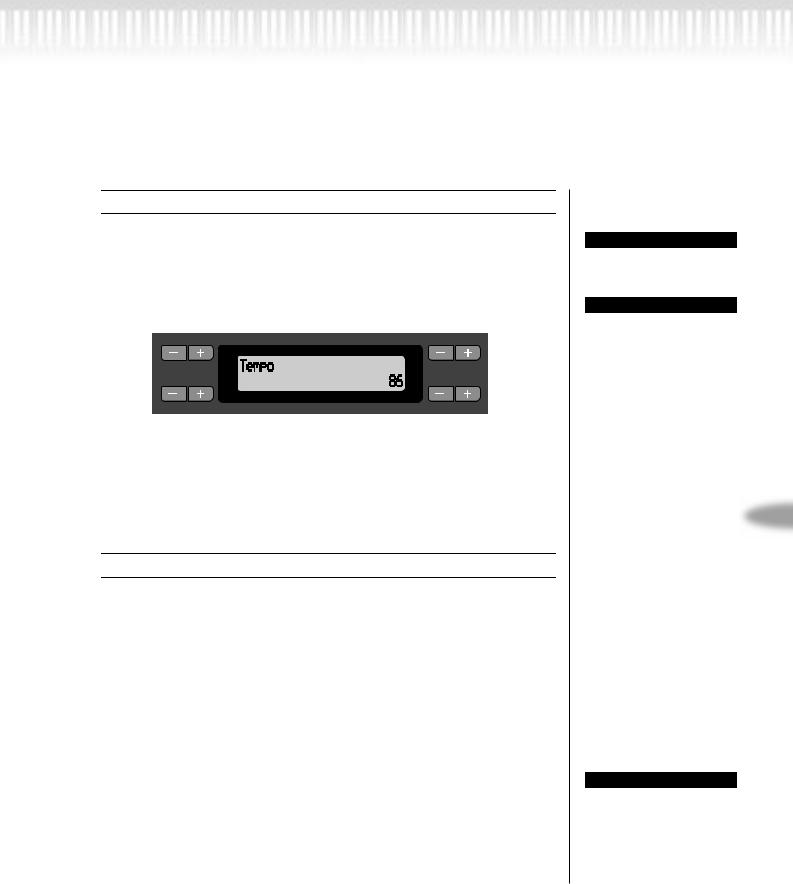
Listening to 50 Piano Preset Songs
Adjusting the tempo
You can use the TEMPO [DOWN]/[UP] buttons to adjust the playback tempo as required. The default tempo (the song’s original tempo) is set when you press the [DOWN] and [UP] buttons simultaneously.
Press either of the SONG SELECT [  ]/[
]/[ 
 ] buttons to return to the song select screen.
] buttons to return to the song select screen.
A B
NO YES
C |
D |
3. Stop the song playback.
When playback is complete, it automatically stops and the Clavinova locates the top of the song. To stop playback in the middle of a song, press the [STOP] button. You can also pause playback by pressing the [START/PAUSE] button. Playback stops when you press the button.
Fast forward and rewind
You can perform the following operations in the song select screen:
•Use the B [–]/[+] buttons to move back and forth (rewind and fast forward) through the song while the song is played or stopped.
•Press the SONG SELECT [  ] or the C [–] button during playback to restart playback from the top of the song.
] or the C [–] button during playback to restart playback from the top of the song.
•Press the SONG SELECT [ 
 ] or the C [+] button during playback to start playback from the next song.
] or the C [+] button during playback to start playback from the next song.
•Press the SONG SELECT [  ] or the C [–] button while playback is stopped in the middle of the song to locate the top of the song.
] or the C [–] button while playback is stopped in the middle of the song to locate the top of the song.
4. Return to the default screen.
Press the [EXIT] button.
TIP
You can also use the D[–]/[+] buttons to change the tempo.
NOTE
Resetting the tempo
Whenever you select a new preset song, the tempo is automatically reset to the song’s original value.
TERMINOLOGY
Default screen:
The default screen is a voice select screen (page 30) that appears when you turn on the power to the Clavinova.
CLP-990 27
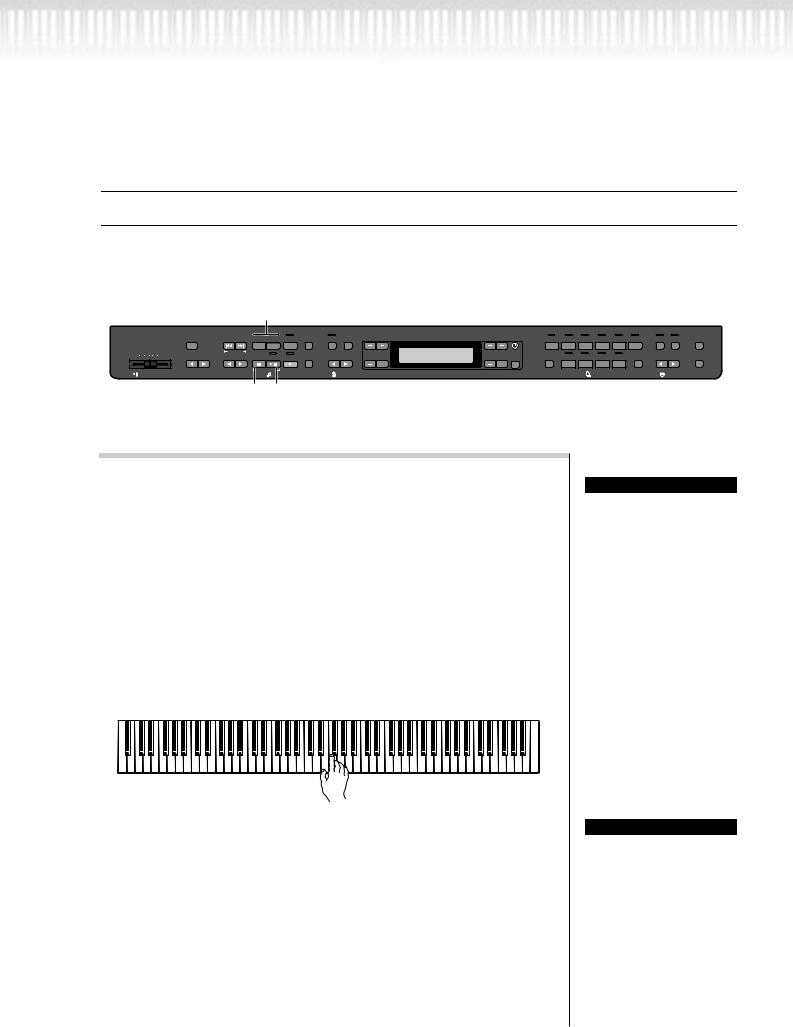
Listening to 50 Piano Preset Songs
Practicing a one-hand part using 50 preset songs
The 50 preset songs have separate leftand right-hand parts on individual tracks. You can turn the leftand right-hand parts on or off as required so you can practice the corresponding part (the part that is turned off) on the keyboard. The right-hand part is played by [TRACK 1] and the left-hand part is played by [TRACK 2].
1
CLP-990 |
DEMO |
SONG SELECT |
TRACK |
TRACK |
EXTRA |
FILE |
METRONOME |
A |
B |
CONTRAST |
PIANO E. PIANO/ |
HARPSI- |
MALLET ORGAN STRINGS/ |
REVERB CHORUS |
MIDI |
|
|
|
1 |
2 |
TRACKS |
|
START/ STOP SETTING |
|
|
|
BASS |
CHORD |
CHOIR |
|
SETTING |
|
|
MAIN |
NEW SONG |
NO |
YES |
MIN |
MAX |
TRANSPOSE |
SONG BALANCE |
STOP START/ |
REC |
SONG |
DOWN UP |
SPLIT |
PIANO/ |
HARPSI/ |
ORGAN/ BASS |
VOICE |
BRILLIANCE |
OTHER |
|
|
|
|
PAUSE |
|
SETTING |
|
POINT |
E. PIANO |
MALLET |
STRINGS |
SETTING |
|
SETTING |
EXIT |
LEFT |
|
SYNCHRO START |
C |
D |
|
MASTER VOLUME |
SONG |
TEMPO |
VOICE |
EFFECT |
3 2
procedure
1. Turn off the playback part you wish to practice.
After you select a song to practice, press the [TRACK1] or [TRACK2] button to turn off the corresponding part.
When you first select a song, both [TRACK1] and [TRACK2] indicators light up, indicating that you can play back both parts. When you press one of the buttons to turn off playback, the corresponding button indicator turns off and the corresponding part playback is muted. Pressing the buttons repeatedly toggles between playback on and off.
2. Start playback and playing.
Press the [START/PAUSE] button to start playback. Play the part you just turned off.
Starting playback automatically as you start playing the keyboard (Synchro Start)
You can start playback as soon as you start playing the keyboard. This is called the “Synchro Start” function.
To enter Synchro Start standby mode, press and hold down the [STOP] button and press the [START/PAUSE] button. The [START/ PAUSE] indicator flashes.
Now play the keyboard. Playback starts simultaneously.
To cancel the Synchro Start function, press the [STOP] button while the Clavinova is in Synchro Start standby mode.
TIP
You can turn parts on or off, even during playback.
TERMINOLOGY
Synchro:
Synchronous;occurring at the same time
28 CLP-990
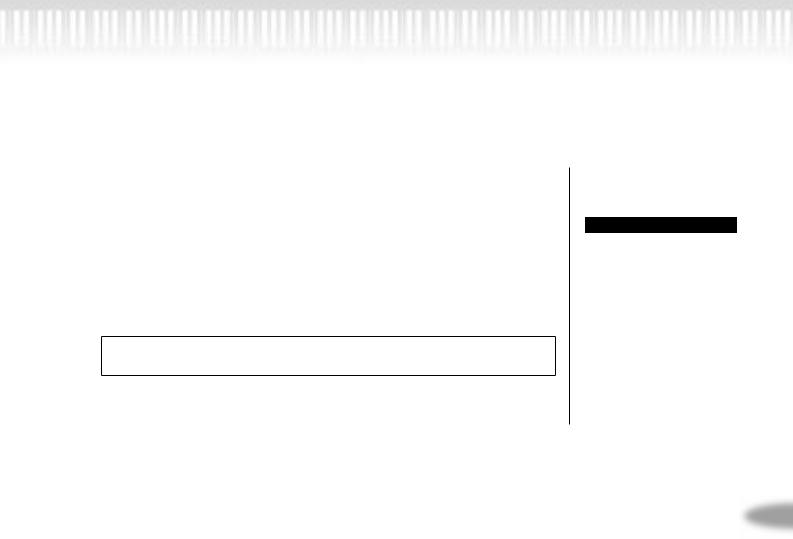
Listening to 50 Piano Preset Songs
3. Stop playback.
When playback is complete, it automatically stops and the Clavinova locates the top of the song. If you wish to stop playback in the middle of a song, press the [STOP] button. You can also pause playback by pressing the [START/PAUSE] button. Playback stops when you press the button.
You can also assign a phrase in a song to repeatedly practice that part. Refer to the [FromToRepeat] option in the “SONG SETTING” menu on page 75.
TIP
Resetting the part playback
Both parts are automatically turned ON whenever you select a new song.
CLP-990 29
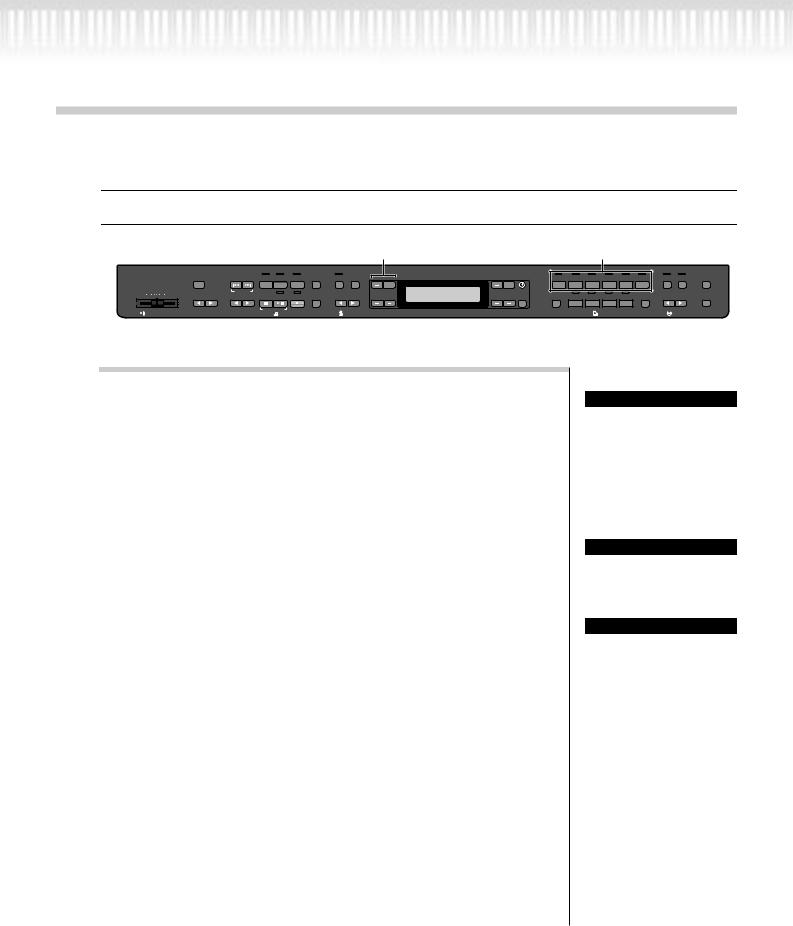
Selecting and Playing Voices
Selecting Voices
|
|
|
|
|
2 |
|
|
MAIN voice |
|
|
|
|
|
|
|
|
1 group buttons |
|
|
CLP-990 |
DEMO |
SONG SELECT TRACK TRACK |
EXTRA FILE |
METRONOME |
A |
B CONTRAST |
PIANO E. PIANO/ HARPSI- |
MALLET ORGAN STRINGS/ REVERB CHORUS |
MIDI |
|
|
1 2 |
TRACKS |
START/ STOP SETTING |
|
|
BASS CHORD |
CHOIR |
SETTING |
|
|
MAIN |
NEW SONG |
NO |
YES |
MIN |
MAX |
TRANSPOSE |
SONG BALANCE |
STOP START/ |
REC |
SONG |
DOWN UP |
SPLIT |
PIANO/ |
HARPSI/ |
ORGAN/ BASS |
VOICE |
BRILLIANCE |
OTHER |
|
|
|
|
PAUSE |
|
SETTING |
|
POINT |
E. PIANO |
MALLET |
STRINGS |
SETTING |
|
SETTING |
EXIT |
LEFT |
|
SYNCHRO START |
C |
D |
|
MASTER VOLUME |
SONG |
TEMPO |
VOICE |
EFFECT |
Procedure
1. Select a voice group.
Press one of the MAIN voice group buttons (upper row).
2. Select a voice.
Use the A [–]/[+] buttons to select a voice.
Voice group |
Voice name |
Voice group |
Voice name |
|
|
|
|
|
|
PIANO |
GrandPiano1 |
|
Vibraphone |
|
|
|
|
||
GrandPiano2 |
MALLET |
Marimba |
||
|
||||
|
|
|
|
|
|
E.Piano1 |
|
Celesta |
|
|
|
|
|
|
|
E.Piano2 |
|
PipeOrganPrincipal |
|
|
|
|
|
|
E.PIANO/ |
SynthPiano |
|
PipeOrganFlute1 |
|
BASS |
WoodBass |
ORGAN |
PipeOrganFlute2 |
|
|
|
|
|
|
|
ElectricBass |
|
PipeOrganTutti |
|
|
|
|
|
|
|
Bass&Cymbal |
|
JazzOrgan |
|
|
|
|
|
|
HARPSI- |
Harpsichord8' |
|
Strings |
|
|
|
|
||
Harpsichord8'+4' |
|
SynthStrings |
||
CHORD |
|
|||
|
|
|
||
ElectricClavichord |
STRINGS/ |
SlowStrings |
||
|
||||
|
|
CHOIR |
Choir |
|
|
|
|
|
|
|
|
|
SlowChoir |
|
|
|
|
|
|
|
|
|
Scat |
|
|
|
|
|
TIP
To learn characteristics of the voices, listen to demo songs for each voice group (page 24). Refer to “Preset Voice List” on page 103 for more information on characteristics of each preset voice.
TERMINOLOGY
Voice
On the Clavinova, a voice means “tone” or “tonal color.”
TIP
You can control the loudness of a voice by how hard you play the keyboard, although different playing styles (touch sensitivities) have little or no effect with the sound of certain musical instruments. Refer to “Preset Voice List” on page 103.
30 CLP-990
